Organic light-emitting device
Ito , et al. July 9, 2
U.S. patent number 10,347,842 [Application Number 15/871,333] was granted by the patent office on 2019-07-09 for organic light-emitting device. This patent grant is currently assigned to Samsung Display Co., Ltd.. The grantee listed for this patent is SAMSUNG DISPLAY CO., LTD.. Invention is credited to Naoyuki Ito, Seul-Ong Kim, Youn-Sun Kim, Jung-Sub Lee, Dong-Woo Shin.






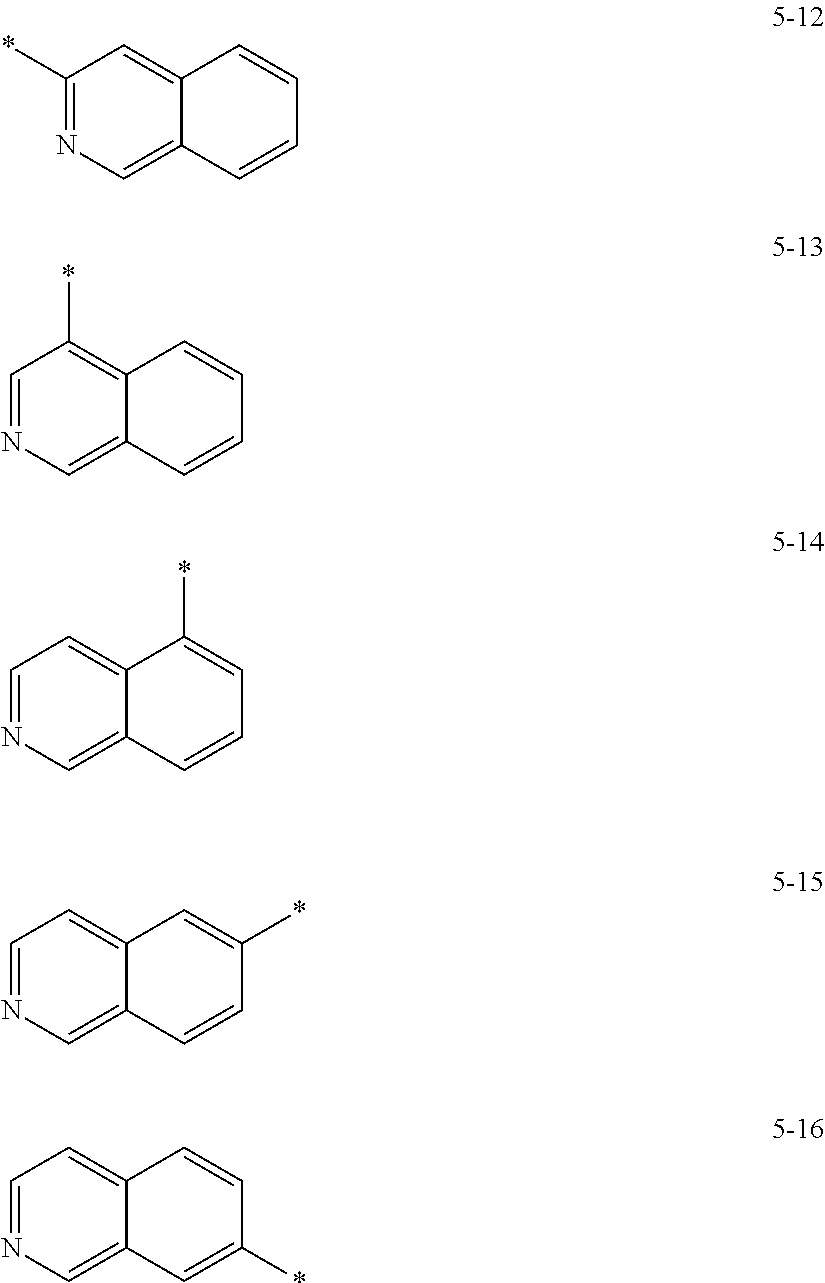



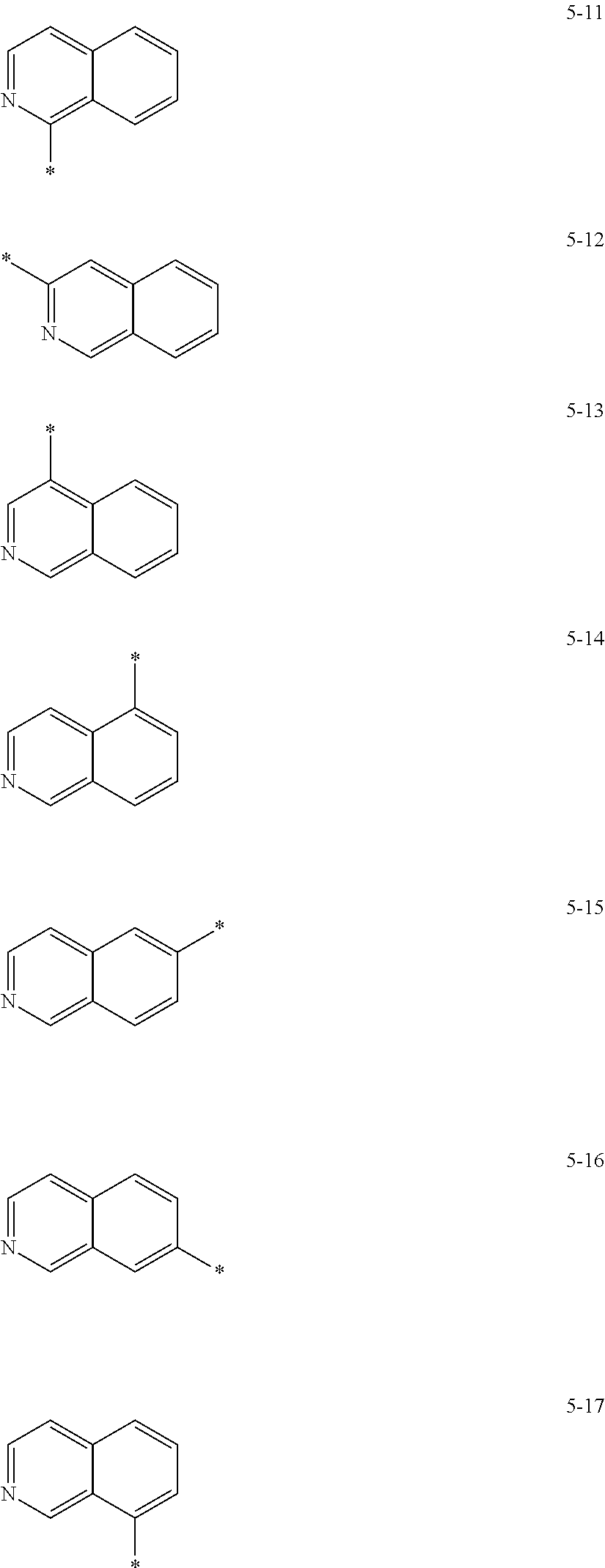
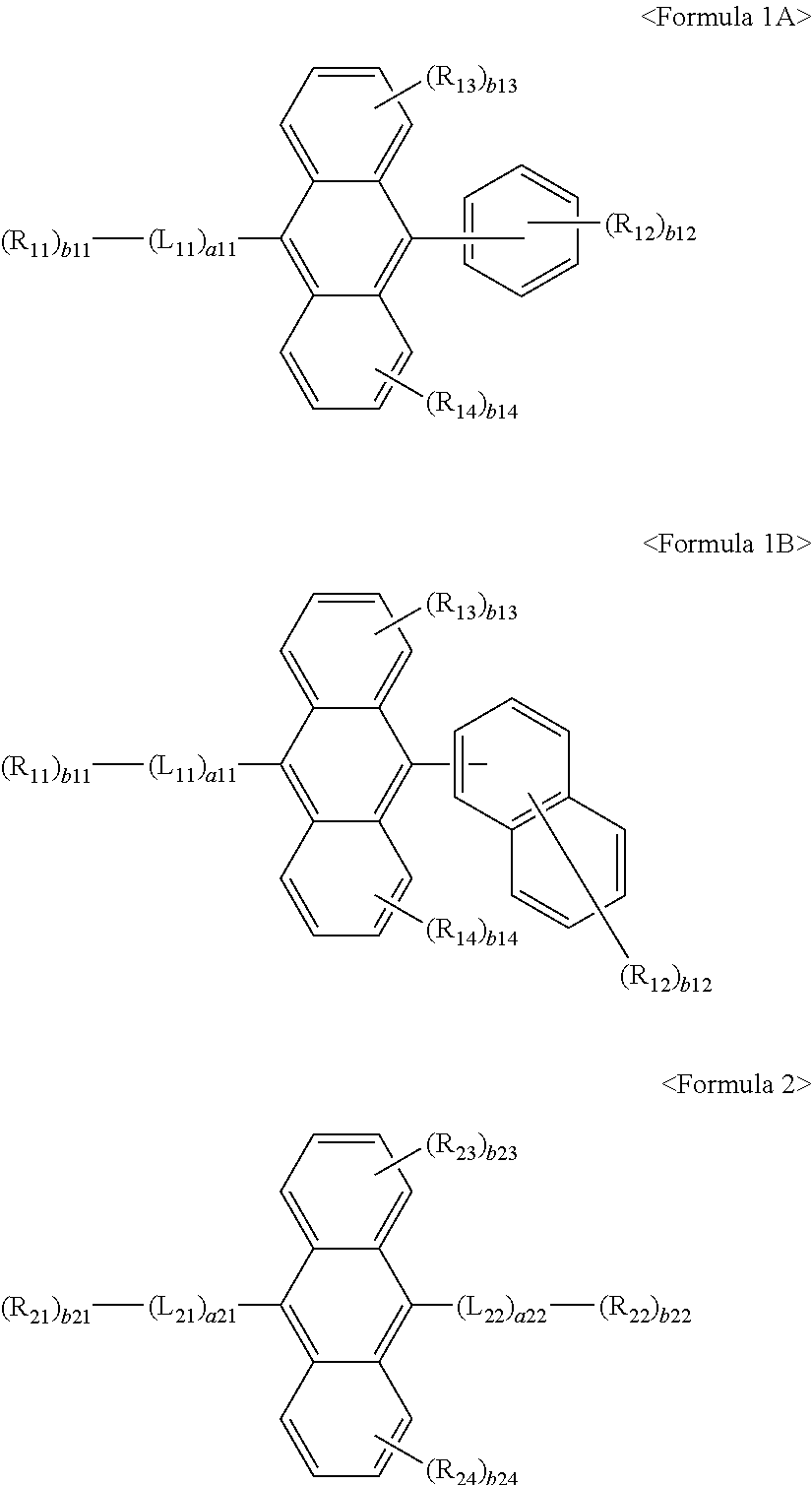
View All Diagrams
| United States Patent | 10,347,842 |
| Ito , et al. | July 9, 2019 |
Organic light-emitting device
Abstract
An organic light-emitting device including a first electrode; a second electrode facing the first electrode; and an organic layer between the first electrode and the second electrode, wherein the organic layer includes at least one first material represented by Formula 1 and at least one second material represented by Formula 2: ##STR00001##
| Inventors: | Ito; Naoyuki (Yongin-si, KR), Kim; Seul-Ong (Yongin-si, KR), Kim; Youn-Sun (Yongin-si, KR), Shin; Dong-Woo (Yongin-si, KR), Lee; Jung-Sub (Yongin-si, KR) | ||||||||||
|---|---|---|---|---|---|---|---|---|---|---|---|
| Applicant: |
|
||||||||||
| Assignee: | Samsung Display Co., Ltd.
(Yongin-Si, Gyeonggi-do, KR) |
||||||||||
| Family ID: | 54770293 | ||||||||||
| Appl. No.: | 15/871,333 | ||||||||||
| Filed: | January 15, 2018 |
Prior Publication Data
| Document Identifier | Publication Date | |
|---|---|---|
| US 20180138417 A1 | May 17, 2018 | |
Related U.S. Patent Documents
| Application Number | Filing Date | Patent Number | Issue Date | ||
|---|---|---|---|---|---|
| 14496756 | Sep 25, 2014 | 9893289 | |||
Foreign Application Priority Data
| Jun 9, 2014 [KR] | 10-2014-0069566 | |||
| Current U.S. Class: | 1/1 |
| Current CPC Class: | H01L 51/0052 (20130101); H01L 51/0058 (20130101); H01L 51/0073 (20130101); H01L 51/5056 (20130101); H01L 51/0061 (20130101); H01L 51/5012 (20130101); H01L 51/5016 (20130101); H01L 51/0072 (20130101); H01L 51/0067 (20130101); H01L 2251/308 (20130101); H01L 51/5072 (20130101); H01L 51/006 (20130101); H01L 51/5096 (20130101); H01L 51/0054 (20130101) |
| Current International Class: | H01L 51/00 (20060101); H01L 51/50 (20060101) |
| Field of Search: | ;428/690 |
References Cited [Referenced By]
U.S. Patent Documents
| 9893289 | February 2018 | Ito |
| 2010/0295445 | November 2010 | Kuma et al. |
| 2012/0305904 | December 2012 | Kai et al. |
| 5208271 | Mar 2013 | JP | |||
| 10-2012-0026513 | Mar 2012 | KR | |||
| 10-2012-0039470 | Apr 2012 | KR | |||
| 10-2012-0041110 | Apr 2012 | KR | |||
| 10-2013-0009765 | Jan 2013 | KR | |||
| WO 2010/137678 | Dec 2010 | WO | |||
| WO 2012/070234 | May 2012 | WO | |||
Attorney, Agent or Firm: Lee & Morse, P.C.
Claims
What is claimed is:
1. An organic light-emitting device, comprising: a first electrode; a second electrode facing the first electrode; and an organic layer between the first electrode and the second electrode, wherein the organic layer includes a first material represented by any one of Formulae 1A and 1B below, and a second material represented by any one of Formulae 2A to 2C below, ##STR00111## wherein in Formulae 1A, 1B, and 2A to 2C, L.sub.11, L.sub.21, and L.sub.22 are each independently selected from a phenylene group and a pyridinylene group; a11 is 0 or 1; a21 and a22 are each independently selected from 0, 1, and 2; R.sub.11 and R.sub.12 are each independently selected from a phenyl group, a naphthyl group, a fluorenyl group, a benzofluorenyl group and a benzothiophenyl group; and a phenyl group, a naphthyl group, a fluorenyl group, a benzofluorenyl group and a benzothiophenyl group, each substituted with at least one selected from a deuterium, --F, --Cl, --Br, --I, a cyano group, a nitro group and a C.sub.1-C.sub.20 alkyl group; R.sub.22 is selected from a pyridyl group, a quinolinyl group, and an isoquinolinyl group; b11, b12, b21, and b22 are 1; R.sub.13, R.sub.14, R.sub.23, and R.sub.24 are a hydrogen; b13, b14, b23, and b24 are 4.
2. The organic light-emitting device as claimed in claim 1, wherein: the first material is represented by any one of Formulae 1A-1 and 1B-1 below, the second material is represented by any one of Formulae 2A to 2C below, ##STR00112## wherein in Formulae 1A-1, 1B-1, and 2A to 2C, L.sub.11, a11, R.sub.11 to R.sub.14, b11 to b14, L.sub.21, L.sub.22, a21, a22, R.sub.22 to R.sub.24, and b22 to b24 are the same as defined with respect to Formulae 1A and 1B and 2A to 2C.
3. The organic light-emitting device as claimed in claim 1, wherein: the organic layer includes: an emission layer, and an electron transport region between the second electrode and the emission layer, the emission layer includes the at least one first material, and the electron transport region includes the at least one second material.
4. The organic light-emitting device as claimed in claim 3, wherein: the electron transport region includes an electron transport layer, and the electron transport layer includes the at least one second material.
5. The organic light-emitting device as claimed in claim 3, wherein: the electron transport region includes a buffer layer, and the buffer layer includes the at least one second material.
Description
CROSS-REFERENCE TO RELATED APPLICATION
Korean Patent Application No. 10-2014-0069566, filed on Jun. 9, 2014, in the Korean Intellectual Property Office, and entitled: "Organic Light-Emitting Device," is incorporated by reference herein in its entirety.
BACKGROUND
1. Field
Embodiments relate to an organic light-emitting device.
2. Description of the Related Art
Organic light emitting devices are self-emission devices that have wide viewing angles, high contrast ratios, short response times, and excellent brightness, driving voltage, and response speed characteristics, and produce full-color images.
The organic light-emitting device may include a first electrode disposed on a substrate, and a hole transport region, an emission layer, an electron transport region, and a second electrode, which are sequentially disposed on the first electrode. Holes provided from the first electrode may move toward the emission layer through the hole transport region, and electrons provided from the second electrode may move toward the emission layer through the electron transport region. Carriers, such as holes and electrons, may be recombined in the emission layer to produce excitons. These excitons may change from an excited state to a ground state, thereby generating light.
SUMMARY
Embodiments are directed to an organic light-emitting device
One or more embodiments provides an organic light-emitting device including a first electrode; a second electrode facing the first electrode; and an organic layer disposed between the first electrode and the second electrode, the organic layer includes at least one material selected from first materials represented by Formula 1 and at least one material selected from second materials represented by Formula 2:
##STR00002##
wherein in Formulae 1 and 2,
L.sub.11, L.sub.21, and L.sub.22 may be each independently selected from a substituted or unsubstituted C.sub.6-C.sub.60 arylene group and a substituted or unsubstituted C.sub.1-C.sub.60 heteroarylene group;
L.sub.12 may be selected from a substituted or unsubstituted phenylene group and a substituted or unsubstituted naphthylenyl group;
a11 may be 0 or 1;
a12 may be 1 or 2;
a21 and a22 may be each independently selected from 0, 1, and 2;
R.sub.11 and R.sub.12 may be each independently selected from a substituted or unsubstituted C.sub.6-C.sub.60 aryl group, a substituted or unsubstituted C.sub.1-C.sub.60 heteroaryl group, a substituted or unsubstituted monovalent non-aromatic condensed polycyclic group, and a substituted or unsubstituted monovalent non-aromatic condensed heteropolycyclic group;
R.sub.21 and R.sub.22 may be each independently selected from a substituted or unsubstituted pyridyl group, a substituted or unsubstituted quinolinyl group, and a substituted or unsubstituted isoquinolinyl group;
b11, b12, b21, and b22 may be each independently selected from 1, 2, and 3;
R.sub.13, R.sub.14, R.sub.23, and R.sub.24 may be each independently selected from a hydrogen, a deuterium, --F, --Cl, --Br, --I, a hydroxyl group, a cyano group, a nitro group, an amino group, an amidino group, a hydrazine group, a hydrazone group, a carboxylic acid or a salt thereof, a sulfonic acid or a salt thereof, a phosphoric acid or a salt thereof, a substituted or unsubstituted C.sub.1-C.sub.60 alkyl group, a substituted or unsubstituted C.sub.1-C.sub.60 alkoxy group, a substituted or unsubstituted C.sub.3-C.sub.10 cycloalkyl group, a substituted or unsubstituted C.sub.6-C.sub.60 aryl group, a substituted or unsubstituted C.sub.6-C.sub.60 aryloxy group, a substituted or unsubstituted C.sub.1-C.sub.60 heteroaryl group a substituted or unsubstituted monovalent non-aromatic condensed polycyclic group, a substituted or unsubstituted monovalent non-aromatic condensed hetero-polycyclic group, and --Si(Q.sub.1)(Q.sub.2)(Q.sub.3);
b13, b14, b23, and b24 may be each independently selected from 1, 2, 3 and 4;
at least one of substituents of the substituted C.sub.6-C.sub.60 arylene group, the substituted C.sub.1-C.sub.60 heteroarylene group, the substituted a phenylene group, the substituted naphthylenyl group, the substituted C.sub.6-60 aryl group, the substituted C.sub.1-C.sub.60 heteroaryl group, the substituted monovalent non-aromatic condensed polycyclic group, the substituted monovalent non-aromatic condensed hetero-polycyclic group, the substituted pyridyl group, the substituted quinolinyl group, the substituted isoquinolinyl group, the substituted C.sub.1-C.sub.60 alkyl group, the substituted C.sub.1-C.sub.60 alkoxy group, the substituted C.sub.3-C.sub.10 cycloalkyl group, and the substituted C.sub.6-C.sub.60 aryloxy group may be selected from
a deuterium, --F, --Cl, --Br, --I, a hydroxyl group, a cyano group, a nitro group, an amino group, an amidino group, a hydrazine group, a hydrazone group, a carboxylic acid group or a salt thereof, a sulfonic acid group or a salt thereof, a phosphoric acid group or a salt thereof, a C.sub.1-C.sub.60 alkyl group, a C.sub.2-C.sub.60 alkenyl group, a C.sub.2-C.sub.60 alkynyl group, and a C.sub.1-C.sub.60 alkoxy group;
a C.sub.1-C.sub.60 alkyl group, a C.sub.2-C.sub.60 alkenyl group, a C.sub.2-C.sub.60 alkynyl group, and a C.sub.1-C.sub.60 alkoxy group, each substituted with at least one selected from a deuterium, --F, --Cl, --Br, --I, a hydroxyl group, a cyano group, a nitro group, an amino group, an amidino group, a hydrazine group, a hydrazone group, a carboxylic acid or a salt thereof, a sulfonic acid or a salt thereof, a phosphoric acid or a salt thereof, a C.sub.3-C.sub.10 cycloalkyl group, a C.sub.2-C.sub.10 heterocycloalkyl group, a C.sub.3-C.sub.10 cycloalkenyl group, a C.sub.2-C.sub.10 heterocycloalkenyl group, a C.sub.6-C.sub.60 aryl group, a C.sub.6-C.sub.60 aryloxy group, a C.sub.6-C.sub.60 arythio group, a C.sub.1-C.sub.60 heteroaryl group, a monovalent non-aromatic condensed polycyclic group, a monovalent non-aromatic condensed hetero-polycyclic group, and --Si(Q.sub.11)(Q.sub.12)(Q.sub.13);
a C.sub.3-C.sub.10 cycloalkyl group, a C.sub.2-C.sub.10 heterocycloalkyl group, a C.sub.3-C.sub.10 cycloalkenyl group, a C.sub.2-C.sub.10 heterocycloalkenyl group, a C.sub.6-C.sub.60 aryl group, a C.sub.6-C.sub.60 aryloxy group, a C.sub.6-C.sub.60 arylthio group, a C.sub.1-C.sub.60 heteroaryl group, a monovalent non-aromatic condensed polycyclic group, and a monovalent non-aromatic condensed heteropolycyclic group;
a C.sub.3-C.sub.10 cycloalkyl group, a C.sub.2-C.sub.10 heterocycloalkyl group, a C.sub.3-C.sub.10 cycloalkenyl group, a C.sub.2-C.sub.10 heterocycloalkenyl group, a C.sub.6-C.sub.60 aryl group, a C.sub.6-C.sub.60 aryloxy group, a C.sub.6-C.sub.60 arythio group, a C.sub.1-C.sub.60 heteroaryl group, a monovalent non-aromatic condensed polycyclic group, and a monovalent non-aromatic condensed hetero-polycyclic group, each substituted with at least one selected from a deuterium, --F, --Cl, --Br, --I, a hydroxyl group, a cyano group, a nitro group, an amino group, an amidino group, a hydrazine group, a hydrazone group, a carboxylic acid or a salt thereof, a sulfonic acid or a salt thereof, a phosphoric acid or a salt thereof, a C.sub.1-C.sub.60 alkyl group, a C.sub.2-C.sub.60 alkenyl group, a C.sub.2-C.sub.60 alkynyl group, a C.sub.1-C.sub.60 alkoxy group, a C.sub.3-C.sub.10 cycloalkyl group, a C.sub.2-C.sub.10 heterocycloalkyl group, a C.sub.3-C.sub.10 cycloalkenyl group, a C.sub.2-C.sub.10 heterocycloalkenyl group, a C.sub.6-C.sub.60 aryl group, a C.sub.6-C.sub.60 aryloxy group, a C.sub.6-C.sub.60 arythio group, a C.sub.1-C.sub.60 heteroaryl group, a monovalent non-aromatic condensed polycyclic group, a monovalent non-aromatic condensed hetero-polycyclic group, and --Si(Q.sub.21)(Q.sub.22)(Q.sub.23); and
--Si(Q.sub.31)(Q.sub.32)(Q.sub.33),
Q.sub.1 to Q.sub.3, Q.sub.11 to Q.sub.13, Q.sub.21 to Q.sub.23 and Q.sub.31 to Q.sub.33 may be each independently selected from a C.sub.1-C.sub.60 alkyl group, a C.sub.6-C.sub.60 aryl group, a C.sub.1-C.sub.6 heteroaryl group, a monovalent non-aromatic condensed polycyclic group, and a monovalent non-aromatic condensed heteropolycyclic group.
BRIEF DESCRIPTION OF THE DRAWING
Features will be apparent to those of skill in the art by describing in detail exemplary embodiments with reference to the attached drawing in which:
FIG. 1 illustrates a schematic cross-sectional view of an organic light-emitting device according to an embodiment.
DETAILED DESCRIPTION
Example embodiments will now be described more fully hereinafter with reference to the accompanying drawing; however, they may be embodied in different forms and should not be construed as limited to the embodiments set forth herein. Rather, these embodiments are provided so that this disclosure will be thorough and complete, and will fully convey exemplary implementations to those skilled in the art.
In the drawing FIGURE, the dimensions of layers and regions may be exaggerated for clarity of illustration. Like reference numerals refer to like elements throughout.
Expressions such as "at least one of," when preceding a list of elements, modify the entire list of elements and do not modify the individual elements of the list.
As used herein, the singular forms "a," "an" and "the" are intended to include the plural forms as well, unless the context clearly indicates otherwise.
It will be further understood that the terms "comprises" and/or "comprising" used herein specify the presence of stated features or components, but do not preclude the presence or addition of one or more other features or components.
It will be understood that when a layer, region, or component is referred to as being "on" or "onto" another layer, region, or component, it can be directly or indirectly formed on the other layer, region, or component. That is, for example, intervening layers, regions, or components may be present.
The term "(an organic layer) includes at least one selected from first materials" or "(an organic layer) includes a first material" used herein includes a case in which "(an organic layer) includes one kind of material selected from first materials represented by Formula 1 and a case in which (an organic layer) includes two or more different kinds of materials selected from first materials represented Formula 1".
In FIG. 1, a substrate may be additionally disposed under a first electrode 110 or above a second electrode 190. The substrate may be a glass substrate or transparent plastic substrate, each with excellent mechanical strength, thermal stability, transparency, surface smoothness, ease of handling, and water repellency.
The first electrode 110 may be formed by depositing or sputtering a material for forming the first electrode on the substrate. When the first electrode 110 is an anode, the material for the first electrode 110 may be selected from materials with a high work function to facilitate hole injection. The first electrode 110 may be a reflective electrode or a transmissive electrode. The material for the first electrode 110 may be a transparent and highly conductive material, and examples of such a material may include indium tin oxide (ITO), indium zinc oxide (IZO), tin oxide (SnO.sub.2), and zinc oxide (ZnO). When the first electrode 110 is a semi-transmissive electrode or a reflective electrode, as a material for forming the first electrode, at least one of magnesium (Mg), aluminum (Al), aluminum-lithium (Al--Li), calcium (Ca), magnesium-indium (Mg--In), magnesium-silver (Mg--Ag) may be used.
The first electrode 110 may have a single-layer structure, or a multi-layer structure including two or more layers. For example, the first electrode 110 may have a three-layered structure of ITO/Ag/ITO, but the structure of the first electrode 110 is not limited thereto.
An organic layer 150 may be disposed on the first electrode 110. The organic layer 150 may include an emission layer.
The organic layer 150 may include at least one selected from first materials represented by Formula 1 and at least one selected from second materials represented by Formula 2. For example, the organic layer 150 may include a first material represented by Formula 1 and a second material represented by Formula 2.
##STR00003##
In Formulae 1 and 2,
L.sub.11, L.sub.21, and L.sub.22 may be each independently selected from a substituted or unsubstituted C.sub.6-C.sub.60 arylene group and a substituted or unsubstituted C.sub.1-C.sub.60 heteroarylene group;
L.sub.12 may be selected from a substituted or unsubstituted phenylene group and a substituted or unsubstituted naphthylenyl group;
a11 may be 0 or 1;
a12 may be 1 or 2;
a21 and a22 may be each independently selected from 0, 1, and 2;
R.sub.11 and R.sub.12 may be each independently selected from a substituted or unsubstituted C.sub.6-C.sub.60 aryl group, a substituted or unsubstituted C.sub.1-C.sub.60 heteroaryl group, a substituted or unsubstituted monovalent non-aromatic condensed polycyclic group, and a substituted or unsubstituted monovalent non-aromatic condensed heteropolycyclic group;
R.sub.21 and R.sub.22 may be each independently selected from a substituted or unsubstituted pyridyl group, a substituted or unsubstituted quinolinyl group, and a substituted or unsubstituted isoquinolinyl group;
b11, b12, b21, and b22 may be each independently selected from 1, 2, and 3;
R.sub.13, R.sub.14, R.sub.23, and R.sub.24 may be each independently selected from a hydrogen, a deuterium, --F, --Cl, --Br, --I, a hydroxyl group, a cyano group, a nitro group, an amino group, an amidino group, a hydrazine group, a hydrazone group, a carboxylic acid or a salt thereof, a sulfonic acid or a salt thereof, a phosphoric acid or a salt thereof, a substituted or unsubstituted C.sub.1-C.sub.60 alkyl group, a substituted or unsubstituted C.sub.1-C.sub.60 alkoxy group, a substituted or unsubstituted C.sub.3-C.sub.10 cycloalkyl group, a substituted or unsubstituted C.sub.6-C.sub.60 aryl group, a substituted or unsubstituted C.sub.6-C.sub.60 aryloxy group, a substituted or unsubstituted C.sub.1-C.sub.60 heteroaryl group a substituted or unsubstituted monovalent non-aromatic condensed polycyclic group, a substituted or unsubstituted monovalent non-aromatic condensed hetero-polycyclic group, and --Si(Q.sub.1)(Q.sub.2)(Q.sub.3);
b13, b14, b23, and b24 may be each independently selected from 1, 2, 3 and 4;
at least one of substituents of the substituted C.sub.6-C.sub.60 arylene group, the substituted C.sub.1-C.sub.60 heteroarylene group, the substituted a phenylene group, the substituted naphthylenyl group, the substituted C.sub.6-C.sub.60 aryl group, the substituted C.sub.1-C.sub.60 heteroaryl group, the substituted monovalent non-aromatic condensed polycyclic group, the substituted monovalent non-aromatic condensed hetero-polycyclic group, the substituted pyridyl group, the substituted quinolinyl group, the substituted isoquinolinyl group, the substituted C.sub.1-C.sub.60 alkyl group, the substituted C.sub.1-C.sub.60 alkoxy group, the substituted C.sub.3-C.sub.10 cycloalkyl group, and the substituted C.sub.6-C.sub.60 aryloxy group may be selected from
a deuterium, --F, --Cl, --Br, --I, a hydroxyl group, a cyano group, a nitro group, an amino group, an amidino group, a hydrazine group, a hydrazone group, a carboxylic acid group or a salt thereof a sulfonic acid group or a salt thereof, a phosphoric acid group or a salt thereof, a C.sub.1-C.sub.60 alkyl group, a C.sub.2-C.sub.60 alkenyl group, a C.sub.2-C.sub.60 alkynyl group, and a C.sub.1-C.sub.60 alkoxy group;
a C.sub.1-C.sub.60 alkyl group, a C.sub.2-C.sub.60 alkenyl group, a C.sub.2-C.sub.60 alkynyl group, and a C.sub.1-C.sub.60 alkoxy group, each substituted with at least one selected from a deuterium, --F, --Cl, --Br, --I, a hydroxyl group, a cyano group, a nitro group, an amino group, an amidino group, a hydrazine group, a hydrazone group, a carboxylic acid or a salt thereof, a sulfonic acid or a salt thereof, a phosphoric acid or a salt thereof, a C.sub.3-C.sub.10 cycloalkyl group, a C.sub.2-C.sub.10 heterocycloalkyl group, a C.sub.3-C.sub.10 cycloalkenyl group, a C.sub.2-C.sub.10 heterocycloalkenyl group, a C.sub.6-C.sub.60 aryl group, a C.sub.6-C.sub.60 aryloxy group, a C.sub.6-C.sub.60 arythio group, a C.sub.1-C.sub.60 heteroaryl group, a monovalent non-aromatic condensed polycyclic group, a monovalent non-aromatic condensed hetero-polycyclic group, and --Si(Q.sub.11)(Q.sub.12)(Q.sub.13);
a C.sub.3-C.sub.10 cycloalkyl group, a C.sub.2-C.sub.10 heterocycloalkyl group, a C.sub.3-C.sub.10 cycloalkenyl group, a C.sub.2-C.sub.10 heterocycloalkenyl group, a C.sub.1-C.sub.60 aryl group, a C.sub.6-C.sub.60 aryloxy group, a C.sub.6-C.sub.60 arylthio group, a C.sub.1-C.sub.60 heteroaryl group, a monovalent non-aromatic condensed polycyclic group, and a monovalent non-aromatic condensed heteropolycyclic group;
a C.sub.3-C.sub.10 cycloalkyl group, a C.sub.2-C.sub.10 heterocycloalkyl group, a C.sub.3-C.sub.10 cycloalkenyl group, a C.sub.2-C.sub.10 heterocycloalkenyl group, a C.sub.6-C.sub.60 aryl group, a C.sub.6-C.sub.60 aryloxy group, a C.sub.6-C.sub.60 arythio group, a C.sub.1-C.sub.60 heteroaryl group, a monovalent non-aromatic condensed polycyclic group, and a monovalent non-aromatic condensed hetero-polycyclic group, each substituted with at least one selected from a deuterium, --F, --Cl, --Br, --I, a hydroxyl group, a cyano group, a nitro group, an amino group, an amidino group, a hydrazine group, a hydrazone group, a carboxylic acid or a salt thereof, a sulfonic acid or a salt thereof, a phosphoric acid or a salt thereof, a C.sub.1-C.sub.60 alkyl group, a C.sub.2-C.sub.60 alkenyl group, a C.sub.2-C.sub.60 alkynyl group, a C.sub.1-C.sub.6 alkoxy group, a C.sub.3-C.sub.10 cycloalkyl group, a C.sub.2-C.sub.10 heterocycloalkyl group, a C.sub.3-C.sub.10 cycloalkenyl group, a C.sub.2-C.sub.10 heterocycloalkenyl group, a C.sub.6-C.sub.60 aryl group, a C.sub.6-C.sub.60 aryloxy group, a C.sub.6-C.sub.60 arythio group, a C.sub.1-C.sub.60 heteroaryl group, a monovalent non-aromatic condensed polycyclic group, a monovalent non-aromatic condensed hetero-polycyclic group, and --Si(Q.sub.21)(Q.sub.22)(Q.sub.23); and
--Si(Q.sub.31)(Q.sub.32)(Q.sub.33),
wherein Q.sub.1 to Q.sub.3, Q.sub.11 to Q.sub.13, Q.sub.21 to Q.sub.23 and Q.sub.31 to Q.sub.33 may be each independently selected from a C.sub.1-C.sub.60 alkyl group, a C.sub.6-C.sub.60 aryl group, a C.sub.1-C.sub.60 heteroaryl group, a monovalent non-aromatic condensed polycyclic group, and a monovalent non-aromatic condensed heteropolycyclic group.
For example, L.sub.11, L.sub.21, and L.sub.22 in Formulae 1 and 2 may be each independently selected from a phenylene group, a naphthylene group, a phenanthrenylene group, an anthracenylene group, a triphenylenylene group, a pyrenylene group, a chrysenylene group, a pyrrolylene group, a thiophenylene group, a furanylene group, an imidazolylene group, a pyridinylene group, a pyrazinylene group, a pyrimidinylene group, a pyridazinylene group, an indolylene indolylene group, a quinolinylene group, an isoquinolinylene group, a benzoquinolinylene group, a phenanthridinylene group, an acridinylene group, a phenanthrolinylene group, a benzofuranylene group, a benzothiophenylene group, a triazolylene group, a tetrazolylene group, a triazinylene triazinylene group, a dibenzofuranylene group, and a dibenzothiophenylene group; and
a phenylene group, a naphthylene group, a phenanthrenylene group, an anthracenylene group, a triphenylenylene group, a pyrenylene group, a chrysenylene group, a pyrrolylene group, a thiophenylene group, a furanylene group, an imidazolylene group, a pyridinylene group, a pyrazinylene group, a pyrimidinylene group, a pyridazinylene group, an indolylene group, a quinolinylene group, an isoquinolinylene group, a benzoquinolinylene group, a phenanthridinylene group, an acridinylene group, a phenanthrolinylene group, a benzofuranylene group, a benzothiophenylene group, a triazolylene group, a tetrazolylene group, a triazinylene group, a dibenzofuranylene group, and a dibenzothiophenylene group, each substituted with at least one selected from a deuterium, --F, --Cl, --Br, --I, a hydroxyl group, a cyano group, a nitro group, an amino group, an amidino group, a hydrazine group, a hydrazone group, a carboxylic acid or a salt thereof, a sulfonic acid or a salt thereof, a phosphoric acid or a salt thereof, a C.sub.1-C.sub.20 alkyl group, a C.sub.1-C.sub.20 alkoxy group, a cyclopentyl group, a cyclohexyl group, a cycloheptyl group, a cyclopentenyl group, a cyclohexenyl group, a phenyl group, a pentalenyl group, an indenyl group, a naphthyl group, an azulenyl group, a heptalenyl group, an indacenyl group, acenaphthyl group, a fluorenyl group, a spiro-fluorenyl group, a benzofluorenyl group, a dibenzofluorenyl group, a phenalenyl group, a phenanthrenyl group, an anthracenyl group, a fluoranthenyl group, a triphenylenyl group, a pyrenyl group, a chrysenyl group, a naphthacenyl group, a picenyl group, a perylenyl group, a pentaphenyl group, a hexacenyl group, a pentacenyl group, a rubicenyl group, a coronenyl group, an ovalenyl group, a pyrrolyl group, a thiophenyl group, a furanyl group, an imidazolyl group, a pyrazolyl group, a thiazolyl group, an isothiazolyl group, an oxazolyl group, an isoxazolyl group, a pyridinyl group, a pyrazinyl group, a pyrimidinyl group, a pyridazinyl group, an isoindolyl group, an indolyl group, an indazolyl group, a purinyl group, a quinolinyl group, an isoquinolinyl group, a benzoquinolinyl group, a phthalazinyl group, a naphthyridinyl group, a quinoxalinyl group, a quinazolinyl group, a cinnolinyl group, a carbazolyl group, a phenanthridinyl group, an acridinyl group, a phenanthrolinyl group, a phenazinyl group, a benzimidazolyl group, a benzofuranyl group, a benzothiophenyl group, an isobenzothiazolyl group, a benzooxazolyl group, an isobenzooxazolyl group, a triazolyl group, a tetrazolyl group, an oxadiazolyl group, a triazinyl group, dibenzofuranyl group, a dibenzothiophenyl group, a benzocarbazolyl group, a dibenzocarbazolyl group, a thiadiazolyl group, and an imidazopyridinyl group, but they are not limited thereto.
In some embodiments, L.sub.11, L.sub.21, and L.sub.22 in Formulae 1 and 2 may be each independently selected from a phenylene group, a naphthylene group, a pyridinylene group, a quinolinylene group and an isoquinolinylene group; and
a phenylene group, a naphthylene group, a pyridinylene group, a quinolinylene group, and an isoquinolinylene group, each substituted with at least one selected from a deuterium, --F, --Cl, --Br, --I, a cyano group, a nitro group, a C.sub.1-C.sub.20 alkyl group, a phenyl group, and a naphthyl group, but they are not limited thereto.
In some embodiments, L.sub.11, L.sub.21, and L.sub.22 in Formulae 1 and 2 may be each independently selected from a group represented by any one of Formulae 3-1 to 3-6, but they are not limited thereto.
##STR00004##
In Formulae 3-1 to 3-6, * and *' indicate binding sites to a neighboring atom.
For example, L.sub.12 in Formula 1 may be selected from a phenylene group and a naphthylenyl group, but is not limited thereto.
a11 in Formula 1 indicates the number of L.sub.11, and when a11 is 0, (L.sub.11).sub.a11 may indicate a direct bond.
a12 in Formula 1 indicates the number of L.sub.12, and when a12 is 2, a plurality of L.sub.12 may be identical or different.
a21 in Formula 2 indicates the number of L.sub.21, and when a21 is 2, a plurality of L.sub.21 may be identical or different. When a21 is 0, (L.sub.21).sub.a21 may indicate a direct bond.
a22 in Formula 2 indicates the number of L.sub.22, and when a22 is 2, a plurality of L.sub.22 may be identical or different. When a22 is 0, (L.sub.22).sub.a22 may indicate a direct bond.
For example, R.sub.11 and R.sub.12 in Formula 1 may be each independently selected from a phenyl group, a pentalenyl group, an indenyl group, a naphthyl group, a azulenyl group, a heptalenyl group, an indacenyl group, an acenaphthyl group, a fluorenyl group, a spiro-fluorenyl group, a benzofluorenyl group, a dibenzofluorenyl group, phenalenyl group, a phenanthrenyl group, an anthracenyl group, a fluoranthenyl group, a triphenylenyl group, a pyrenyl group, a chrysenyl group, a naphthacenyl group, a picenyl group, a perylenyl group, a pentaphenyl group, a hexacenyl group, a pentacenyl group, a rubicenyl group, a coronenyl group, a ovalenyl group, a pyrrolyl group, a thiophenyl group, a furanyl group, a imidazolyl group, a pyrazolyl group, a thiazolyl group, an isothiazolyl group, a oxazolyl group, an isoxazolyl group, a pyridinyl group, a pyrazinyl group, a pyrimidinyl group, a pyridazinyl group, an isoindolyl group, an indolyl group, an indazolyl group, a purinyl group, a quinolinyl group, an isoquinolinyl group, a carbazolyl group, a benzoquinolinyl group, a phthalazinyl group, a naphthyridinyl group, a quinoxalinyl group, a quinazolinyl group, a cinnolinyl group, a phenanthridinyl group, an acridinyl group, a phenanthrolinyl group, a phenazinyl group, a benzimidazolyl group, a benzofuranyl group, a benzothiophenyl group, an isobenzothiazolyl group, a benzooxazolyl group, an isobenzooxazolyl group, a triazolyl group, a tetrazolyl group, an oxadiazolyl group, a triazinyl group, a dibenzofuranyl group, a dibenzothiophenyl group, a dibenzosilolyl group, a benzocarbazolyl group, and a dibenzocarbazolyl group; and
a phenyl group, a pentalenyl group, an indenyl group, a naphthyl group, an azulenyl group, a heptalenyl group, an indacenyl group, acenaphthyl group, a fluorenyl group, a spiro-fluorenyl group, a benzofluorenyl group, a dibenzofluorenyl group, a phenalenyl group, a phenanthrenyl group, an anthracenyl group, a fluoranthenyl group, a triphenylenyl group, a pyrenyl group, a chrysenyl group, a naphthacenyl group, a picenyl group, a perylenyl group, a pentaphenyl group, a hexacenyl group, a pentacenyl group, a rubicenyl group, a coronenyl group, an ovalenyl group, a pyrrolyl group, a thiophenyl group, a furanyl group, an imidazolyl group, a pyrazolyl group, a thiazolyl group, an isothiazolyl group, an oxazolyl group, an isoxazolyl group, a pyridinyl group, a pyrazinyl group, a pyrimidinyl group, a pyridazinyl group, an isoindolyl group, an indolyl group, an indazolyl group, a purinyl group, a quinolinyl group, an isoquinolinyl group, a carbazolyl group, a benzoquinolinyl group, a phthalazinyl group, a naphthyridinyl group, a quinoxalinyl group, a quinazolinyl group, a cinnolinyl group, a phenanthridinyl group, an acridinyl group, a phenanthrolinyl group, a phenazinyl group, a benzimidazolyl group, a benzofuranyl group, a benzothiophenyl group, an isobenzothiazolyl group, a benzooxazolyl group, an isobenzooxazolyl group, a triazolyl group, a tetrazolyl group, an oxadiazolyl group, a triazinyl group, dibenzofuranyl group, a dibenzothiophenyl group, a dibenzosilolyl group, a benzocarbazolyl group, and a dibenzocarbazolyl group, each substituted with at least one selected from a deuterium, --F, --Cl, --Br, --I, a hydroxyl group, a cyano group, a nitro group, an amino group, an amidino group, a hydrazine group, a hydrazone group, a carboxylic acid or a salt thereof, a sulfonic acid or a salt thereof, a phosphoric acid or a salt thereof, a C.sub.1-C.sub.20 alkyl group, a C.sub.1-C.sub.20 alkoxy group, a phenyl group, a pentalenyl group, an indenyl group, a naphthyl group, an azulenyl group, a heptalenyl group, an indacenyl group, acenaphthyl group, a fluorenyl group, a spiro-fluorenyl group, a benzofluorenyl group, a dibenzofluorenyl group, a phenalenyl group, a phenanthrenyl group, an anthracenyl group, a fluoranthenyl group, a triphenylenyl group, a pyrenyl group, a chrysenyl group, a naphthacenyl group, a picenyl group, a perylenyl group, a pentaphenyl group, a hexacenyl group, a pentacenyl group, a rubicenyl group, a coronenyl group, an ovalenyl group, a pyrrolyl group, a thiophenyl group, a furanyl group, an imidazolyl group, a pyrazolyl group, a thiazolyl group, an isothiazolyl group, an oxazolyl group, an isoxazolyl group, a pyridinyl group, a pyrazinyl group, a pyrimidinyl group, a pyridazinyl group, an isoindolyl group, an indolyl group, an indazolyl group, a purinyl group, a quinolinyl group, an isoquinolinyl group, a carbazolyl group, a benzoquinolinyl group, a phthalazinyl group, a naphthyridinyl group, a quinoxalinyl group, a quinazolinyl group, a cinnolinyl group, a carbazolyl group, a phenanthridinyl group, an acridinyl group, a phenanthrolinyl group, a phenazinyl group, a benzimidazolyl group, a benzofuranyl group, a benzothiophenyl group, an isobenzothiazolyl group, a benzooxazolyl group, an isobenzooxazolyl group, a triazolyl group, a tetrazolyl group, an oxadiazolyl group, a triazinyl group, dibenzofuranyl group, a dibenzothiophenyl group, a benzocarbazolyl group, and a dibenzocarbazolyl group, but they are not limited thereto.
In some embodiments, R.sub.11 and R.sub.12 in Formula 1 may be each independently selected from a phenyl group, a naphthyl group, a fluorenyl group, a benzofluorenyl group, a dibenzofluorenyl group, a phenanthrenyl group, an anthracenyl group, a fluoranthenyl group, a triphenylenyl group, a pyrenyl group, a chrysenyl group, a pyrrolyl group, a thiophenyl group, a furanyl group, an imidazolyl group, a pyrazolyl group, a thiazolyl group, an isothiazolyl group, an oxazolyl group, an isoxazolyl group, a pyridinyl group, a pyrazinyl group, a pyrimidinyl group, a pyridazinyl group, an isoindolyl group, an indolyl group, an indazolyl group, a quinolinyl group, an isoquinolinyl group, a carbazolyl group, a benzoquinolinyl group, a phthalazinyl group, a phenanthridinyl group, an acridinyl group, a phenanthrolinyl group, a phenazinyl group, a benzimidazolyl group, a benzofuranyl group, a benzothiophenyl group, an isobenzothiazolyl group, a benzooxazolyl group, an isobenzooxazolyl group, a triazolyl group, a tetrazolyl group, an oxadiazolyl group, a triazinyl group, dibenzofuranyl group, a dibenzothiophenyl group, a dibenzosilolyl group, a benzocarbazolyl group, and a dibenzocarbazolyl group; and
a phenyl group, a naphthyl group, a fluorenyl group, a benzofluorenyl group, a dibenzofluorenyl group, a phenanthrenyl group, an anthracenyl group, a fluoranthenyl group, a triphenylenyl group, a pyrenyl group, a chrysenyl group, a pyrrolyl group, a thiophenyl group, a furanyl group, an imidazolyl group, a pyrazolyl group, a thiazolyl group, an isothiazolyl group, an oxazolyl group, an isoxazolyl group, a pyridinyl group, a pyrazinyl group, a pyrimidinyl group, a pyridazinyl group, an isoindolyl group, an indolyl group, an indazolyl group, a quinolinyl group, an isoquinolinyl group, a carbazolyl group, a benzoquinolinyl group, a phthalazinyl group, a phenanthridinyl group, an acridinyl group, a phenanthrolinyl group, a phenazinyl group, a benzimidazolyl group, a benzofuranyl group, a benzothiophenyl group, an isobenzothiazolyl group, a benzooxazolyl group, an isobenzooxazolyl group, a triazolyl group, a tetrazolyl group, an oxadiazolyl group, a triazinyl group, dibenzofuranyl group, a dibenzothiophenyl group, a dibenzosilolyl group, a benzocarbazolyl group, and a dibenzocarbazolyl group, each substituted with at least one selected from a deuterium, --F, --Cl, --Br, --I, a cyano group, a nitro group, a C.sub.1-C.sub.20 alkyl group, a phenyl group, and a naphthyl group, but they are not limited thereto.
In some embodiments, R.sub.11 and R.sub.12 in Formula 1 may be each independently selected from a phenyl group, a naphthyl group, a fluorenyl group, a benzofluorenyl group, a dibenzofluorenyl group, a phenanthrenyl group, an anthracenyl group, a fluoranthenyl group, a triphenylenyl group, a pyrenyl group, a chrysenyl group, a furanyl group, a thiophenyl group, a carbazolyl group, a benzofuranyl group, a benzothiophenyl group, dibenzofuranyl group, a dibenzothiophenyl group, a dibenzosilolyl group, a benzocarbazolyl group, and a dibenzocarbazolyl group; and
a phenyl group, a naphthyl group, a fluorenyl group, a benzofluorenyl group, a dibenzofluorenyl group, a phenanthrenyl group, an anthracenyl group, a fluoranthenyl group, a triphenylenyl group, a pyrenyl group, a chrysenyl group, a furanyl group, a thiophenyl group, a carbazolyl group, a benzofuranyl group, a benzothiophenyl group, dibenzofuranyl group, a dibenzothiophenyl group, a dibenzosilolyl group, a benzocarbazolyl group, and a dibenzocarbazolyl group, each substituted with at least one selected from a deuterium, --F, --Cl, --Br, --I, a cyano group, a nitro group, a C.sub.1-C.sub.20 alkyl group, a phenyl group, and a naphthyl group, but they are not limited thereto.
In other embodiments, R.sub.11 and R.sub.12 in Formula 1 may be each independently selected from a group represented by any one of one of Formulae 4-1 to 4-9 below, but they are not limited thereto.
##STR00005##
In Formulae 4-1 to 4-9, * indicates a binding site to a neighboring atom.
For example, R.sub.21 and R.sub.22 in Formula 2 may be each independently selected from a pyridyl group, a quinolinyl group, and an isoquinolinyl group, but they are not limited thereto.
In some embodiments, R.sub.21 and R.sub.22 in Formula 2 may be each independently selected from a group represented by any one of one of Formulae 5-1 to 5-17 below, but they are not limited thereto.
##STR00006## ##STR00007##
In Formulae 5-1 to 5-17, * indicates a binding site to a neighboring atom.
In some embodiments, R.sub.21 and R.sub.22 in Formula 2 may be each independently a group selected from Formulae 5-1, 5-2, 5-5, and 5-13, but they are not limited thereto.
##STR00008##
In Formulae 5-1, 5-2, 5-5, and 5-13, * indicates a binding site to a neighboring atom.
b11, b12, b21 and b22 in Formula 1 and 2 respectively indicate the number of R.sub.11, R.sub.12, R.sub.21, and R.sub.22 and when each of b11, b12, b21, and b22 is 2 or 3, a plurality of R.sub.11, R.sub.12, R.sub.21, and R.sub.22 may be identical or different.
For example, R.sub.13, R.sub.14, R.sub.23, and R.sub.24 in Formulae 1 and 2 may be each independently selected from a hydrogen, a deuterium, --F, --Cl, --Br, --I, a cyano group, a nitro group, a methyl group, an ethyl group, n-a propyl group, iso-a propyl group, an n-butyl group, a sec-butyl group, iso-butyl group, a tert-butyl group, an n-pentyl group, an n-hexyl group, an n-heptyl group, an n-octyl group, a phenyl group, a pentalenyl group, an indenyl group, a naphthyl group, an azulenyl group, a heptalenyl group, an indacenyl group, acenaphthyl group, a fluorenyl group, a spiro-fluorenyl group, a benzofluorenyl group, a dibenzofluorenyl group, a phenalenyl group, a phenanthrenyl group, an anthracenyl group, a fluoranthenyl group, a triphenylenyl group, a pyrenyl group, a chrysenyl group, a naphthacenyl group, a picenyl group, a perylenyl group, a pentaphenyl group, a hexacenyl group, a pentacenyl group, a rubicenyl group, a coronenyl group, an ovalenyl group, a pyrrolyl group, a thiophenyl group, a furanyl group, an imidazolyl group, a pyrazolyl group, a thiazolyl group, an isothiazolyl group, an oxazolyl group, an isoxazolyl group, a pyridinyl group, a pyrazinyl group, a pyrimidinyl group, a pyridazinyl group, an isoindolyl group, an indolyl group, an indazolyl group, a purinyl group, a quinolinyl group, an isoquinolinyl group, a carbazolyl group, a benzoquinolinyl group, a phthalazinyl group, a naphthyridinyl group, a quinoxalinyl group, a quinazolinyl group, a cinnolinyl group, a phenanthridinyl group, an acridinyl group, a phenanthrolinyl group, a phenazinyl group, a benzimidazolyl group, a benzofuranyl group, a benzothiophenyl group, an isobenzothiazolyl group, a benzooxazolyl group, an isobenzooxazolyl group, a triazolyl group, a tetrazolyl group, an oxadiazolyl group, a triazinyl group, dibenzofuranyl group, a dibenzothiophenyl group, a dibenzosilolyl group, a benzocarbazolyl group, and a dibenzocarbazolyl group, but they are not limited thereto.
In some embodiments, R.sub.13, R.sub.14, R.sub.23, and R.sub.24 in Formulae 1 and 2 may be each independently selected from a hydrogen, a deuterium, --F, --Cl, --Br, --I, a cyano group, a nitro group, a methyl group, an ethyl group, n-a propyl group, iso-a propyl group, an n-butyl group, a sec-butyl group, iso-butyl group, a tert-butyl group, an n-pentyl group, an n-hexyl group, an n-heptyl group, and an n-octyl group, a group represented by one of Formulae 4-1 to 4-9 and a group represented by one of Formulae 5-1 to 5-17, but they are not limited thereto.
##STR00009## ##STR00010## ##STR00011##
In Formulae 4-1 to 4-9 and 5-1 to 5-17, * indicates a binding site to a neighboring atom.
b13, b14, b23, and b24 in Formula 1 and 2 respectively indicate the number of R.sub.13, R.sub.14, R.sub.23, and R.sub.24, and when each of b13, b14, b23, and b24 is selected from 2, 3, and 4, a plurality of R.sub.13, R.sub.14, R.sub.23, and R.sub.24 may be identical or different.
For example, the first materials may be represented by any one of Formulae 1A and 1B below, and the second materials may be represented by Formula 2 below, but they are not limited thereto.
##STR00012##
In Formulae 1A, 1B, and 2, L.sub.11, a11, R.sub.11 to R.sub.14, b11 to b14, L.sub.21, L.sub.22, a21, a22, R.sub.21 to R.sub.24, and b21 to b24 have already described above.
In some embodiments, the first materials may be represented by any one of Formulae 1A and 1B below, and the second materials may be represented by one of Formulae 2A to 2C below, but they are not limited thereto.
##STR00013##
In Formulae 1A, 1B, and 2A to 2C, L.sub.11, a11, R.sub.11 to R.sub.14, b11 to b14, L.sub.21, L.sub.22, a21, a22, R.sub.22 to R.sub.24, and b22 to b24 have already described above.
In some embodiments, the first materials may be represented by any one of Formulae 1A-1 and 1B-1 below, and the second materials may be represented by one of Formulae 2A to 2C below, but they are not limited thereto.
##STR00014##
In Formulae 1A-1, 1B-1, and 2A to 2C, L.sub.11, a11, R.sub.11 to R.sub.14, b11 to b14, L.sub.21, L.sub.22, a21, a22, R.sub.22 to R.sub.24, and b22 to b24 have already described above.
In some embodiments, the first materials may be selected from Compounds 100 to 263 below, and the second materials may be selected from Compounds 300 to 397, but they are not limited thereto.
##STR00015## ##STR00016## ##STR00017## ##STR00018## ##STR00019## ##STR00020## ##STR00021## ##STR00022## ##STR00023## ##STR00024## ##STR00025## ##STR00026## ##STR00027## ##STR00028## ##STR00029## ##STR00030## ##STR00031## ##STR00032## ##STR00033## ##STR00034## ##STR00035## ##STR00036## ##STR00037## ##STR00038## ##STR00039## ##STR00040## ##STR00041## ##STR00042## ##STR00043## ##STR00044## ##STR00045## ##STR00046## ##STR00047## ##STR00048## ##STR00049## ##STR00050## ##STR00051## ##STR00052## ##STR00053## ##STR00054## ##STR00055## ##STR00056## ##STR00057## ##STR00058## ##STR00059## ##STR00060## ##STR00061## ##STR00062## ##STR00063## ##STR00064##
The second materials represented by Formula 2 may have high electron mobility. The first materials represented by Formula 1 may have higher efficiency in combination with an electron trapping dopant. Generally, in order to stably trap excitons in an emission layer, stability of an electron transporting material may be considered. The second materials represented by Formula 2 may have high stability, and a lifespan of an organic light-emitting device including the second materials may be improved.
Accordingly, an organic emitting device including the first materials represented by Formula 1 and the second materials represented by Formula 2 may have high efficiency and a long lifespan.
The organic layer 150 may further include a hole transport region 130 between the first electrode and the emission layer. The organic layer 150 may further include an electron transport region 180 between the emission layer and the second electrode.
The hole transport region 130 may include at least one selected from a hole injection layer (HIL), a hole transport layer (HTL), a buffer layer, and an electron blocking layer (EBL), and the electron transport region 180 may include at least one selected from a buffer layer, an electron transport layer (ETL), and an electron injection layer (EIL), but they are not limited thereto.
The hole transport region 130 may have a single-layered structure formed of a single material, a single-layered structure formed of a plurality of different materials, or a multi-layered structure having a plurality of layers formed of a plurality of different materials.
For example, the hole transport region 130 may have a single-layered structure formed of a plurality of different materials, or a structure of hole injection layer/hole transport layer, a structure of hole injection layer/hole transport layer/buffer layer, a structure of hole injection layer/buffer layer, a structure of hole transport layer/buffer layer, or a structure of hole injection layer/hole transport layer/electron blocking layer, wherein layers of each structure are sequentially stacked from the first electrode 110 in this stated order, but are not limited thereto.
When the hole transport region 130 includes a hole injection layer, the hole injection layer may be formed on the first electrode 110 by using various methods, such as vacuum deposition, spin coating casting, a Langmuir-Blodgett (LB) method, ink-jet printing, laser-printing, or laser-induced thermal imaging.
When a hole injection layer is formed by vacuum deposition, for example, the vacuum deposition may be performed at a temperature of a deposition temperature of about 100 to about 500.degree. C., at a vacuum degree of about 10.sup.-8 to about 10.sup.-3 torr, and at a deposition rate of about 0.01 to about 100 .ANG./sec, in consideration of a compound for a hole injection layer to be deposited, and the structure of a hole injection layer to be formed.
When a hole injection layer is formed by spin coating, the spin coating may be performed at a coating rate of about 2,000 rpm to about 5,000 rpm, and at a temperature of about 80.degree. C. to 200.degree. C., in consideration of a compound for a hole injection layer to be deposited, and the structure of a hole injection layer to be formed.
When the hole transport region 130 includes a hole transport layer, the hole transport layer may be formed on the first electrode 110 or the hole injection layer by using various methods, such as vacuum deposition, spin coating, casting, a LB method, ink-jet printing, laser-printing, or laser-induced thermal imaging. When the hole transport layer is formed by vacuum deposition or spin coating, deposition and coating conditions for the hole transport layer may be determined by referring to the deposition and coating conditions for the hole injection layer.
The hole transport region 130 may include at least one selected from m-MTDATA, TDATA, 2-TNATA, NPB, 3-NPB, TPD, Spiro-TPD, Spiro-NPB, .alpha.-NPB, TAPC, HMTPD, 4,4',4''-tris(N-carbazolyl)triphenylamine (TCTA), polyaniline/dodecylbenzenesulfonic acid (Pani/DBSA), poly(3,4-ethylenedioxythiophene)/poly(4-styrenesulfonate) (PEDOT/PSS), polyaniline/camphor sulfonicacid (Pani/CSA), (polyaniline)/poly(4-styrenesulfonate) (PANI/PSS), a compound represented by Formula 201 below, and a compound represented by Formula 202 below.
##STR00065## ##STR00066## ##STR00067##
In Formulae 201 and 202,
L.sub.201 to L.sub.205 may be each independently selected from a substituted or unsubstituted C.sub.3-C.sub.10 cycloalkylene, a substituted or unsubstituted C.sub.3-C.sub.10 heterocycloalkylene, a substituted or unsubstituted C.sub.3-C.sub.10 cycloalkenylene, a substituted or unsubstituted C.sub.3-C.sub.10 heterocycloalkenylene, a substituted or unsubstituted C.sub.6-C.sub.60 arylene, a substituted or unsubstituted C.sub.2-C.sub.60 heteroarylene, and a substituted or unsubstituted bivalent non-aromatic condensed polycyclic group,
at least one of substituents of the substituted C.sub.3-C.sub.10 cycloalkylene, the substituted C.sub.3-C.sub.10 heterocycloalkylene, substituted C.sub.3-C.sub.10 cycloalkenylene, substituted C.sub.3-C.sub.10 heterocycloalkenylene, substituted C.sub.6-C.sub.60 arylene, substituted C.sub.2-C.sub.60 heteroarylene, and a substituted bivalent non-aromatic condensed polycyclic group may be selected from
a deuterium, a halogen atom, a hydroxyl, a cyano, a nitro, an amino, an amidino, a hydrazine, a hydrazone, a carboxylic acid and a salt thereof, a sulfonic acid and a salt thereof, a phosphoric acid and a salt thereof, a C.sub.1-C.sub.60 alkyl, a C.sub.2-C.sub.60 alkenyl, a C.sub.2-C.sub.60 alkynyl, and a C.sub.1-C.sub.60 alkoxy;
a C.sub.1-C.sub.60 alkyl, a C.sub.2-C.sub.60 alkenyl, a C.sub.2-C.sub.60 alkynyl, and a C.sub.1-C.sub.60 alkoxy, each substituted with at least one selected from a deuterium, a halogen atom, a hydroxyl, a cyano, a nitro, an amino, an amidino, a hydrazine, a hydrazone, a carboxylic acid and a salt thereof, a sulfonic acid and a salt thereof, a phosphoric acid and a salt thereof, a C.sub.3-C.sub.10 cycloalkyl, a C.sub.3-C.sub.10 heterocycloalkyl, a C.sub.3-C.sub.10 cycloalkenyl, a C.sub.3-C.sub.10 heterocycloalkenyl, a C.sub.6-C.sub.60 aryl, a C.sub.6-C.sub.60 aryloxy, a C.sub.6-C.sub.60 arylthio, a C.sub.2-C.sub.60 heteroaryl, a monovalent non-aromatic condensed polycyclic, a monovalent non-aromatic condensed heteropolycyclic, --N(Q.sub.201)(Q.sub.202), --Si(Q.sub.203)(Q.sub.204)(Q.sub.205), and --B(Q.sub.206)(Q.sub.207);
a C.sub.3-C.sub.10 cycloalkyl group, a C.sub.3-C.sub.10 heterocycloalkyl group, a C.sub.3-C.sub.10 cycloalkenyl group, a C.sub.3-C.sub.10 heterocycloalkenyl group, a C.sub.6-C.sub.60 aryl group, a C.sub.6-C.sub.60 aryloxy group, a C.sub.6-C.sub.60 arythio group, a C.sub.2-C.sub.60 heteroaryl group, a monovalent non-aromatic condensed polycyclic group, and a monovalent non-aromatic condensed heteropolycyclic group;
a C.sub.3-C.sub.10 cycloalkyl, a C.sub.3-C.sub.0 heterocycloalkyl, a C.sub.3-C.sub.10 cycloalkenyl, a C.sub.3-C.sub.10 heterocycloalkenyl, a C.sub.6-C.sub.60 aryl, a C.sub.6-C.sub.60 aryloxy, a C.sub.6-C.sub.60 arythio, a C.sub.2-C.sub.60 heteroaryl, a monovalent non-aromatic condensed polycyclic group, and a monovalent non-aromatic condensed heteropolycyclic group, each substituted with at least one selected from a deuterium, a halogen atom, a hydroxyl, a cyano, a nitro, an amino, an amidino, a hydrazine, a hydrazone, a carboxylic acid and a salt thereof, a sulfonic acid and a salt thereof, a phosphoric acid and a salt thereof, a C.sub.1-C.sub.60 alkyl, a C.sub.2-C.sub.60 alkenyl, a C.sub.2-C.sub.60 alkynyl, a C.sub.1-C.sub.60 alkoxy, a C.sub.3-C.sub.10 cycloalkyl, a C.sub.3-C.sub.10 heterocycloalkyl, a C.sub.3-C.sub.10 cycloalkenyl, a C.sub.3-C.sub.10 heterocycloalkenyl, a C.sub.6-C.sub.60 aryl, a C.sub.6-C.sub.60 aryloxy, a C.sub.6-C.sub.60 arythio, a C.sub.2-C.sub.60 heteroaryl, a monovalent non-aromatic condensed polycyclic group, a monovalent non-aromatic condensed heteropolycyclic group, --N(Q.sub.211)(Q.sub.212), --Si(Q.sub.213)(Q.sub.214)(Q.sub.215), and --B(Q.sub.216)(Q.sub.217); and
--N(Q.sub.221)(Q.sub.222), --Si(Q.sub.223)(Q.sub.224)(Q.sub.225), and --B(Q.sub.226)(Q.sub.227),
xa1 to xa4 may be each independently selected from 0, 1, 2, and 3;
xa5 may be selected from 1, 2, 3, 4, and 5; and
R.sub.201 to R.sub.204 may be each independently selected from
a C.sub.1-C.sub.60 alkyl, a C.sub.2-C.sub.60 alkenyl, a C.sub.2-C.sub.60 alkynyl, and a C.sub.1-C.sub.60 alkoxy;
a C.sub.1-C.sub.60 alkyl, a C.sub.2-C.sub.60 alkenyl, a C.sub.2-C.sub.60 alkynyl, and a C.sub.1-C.sub.60 alkoxy, each substituted with at least one selected from a deuterium, a halogen atom, a hydroxyl, a cyano, a nitro, an amino, an amidino, a hydrazine, a hydrazone, a carboxylic acid and a salt thereof, a sulfonic acid and a salt thereof, a phosphoric acid and a salt thereof, a C.sub.3-C.sub.10 cycloalkyl, a C.sub.3-C.sub.10 heterocycloalkyl, a C.sub.3-C.sub.10 cycloalkenyl, a C.sub.3-C.sub.10 heterocycloalkenyl, a C.sub.6-C.sub.60 aryl, a C.sub.6-C.sub.60 aryloxy, a C.sub.6-C.sub.60 arylthio, a C.sub.2-C.sub.60 heteroaryl, a monovalent non-aromatic condensed polycyclic, --N(Q.sub.231)(Q.sub.232), --Si(Q.sub.233)(Q.sub.234)(Q.sub.235), and --B(Q.sub.236)(Q.sub.237);
a C.sub.3-C.sub.10 cycloalkyl group, a C.sub.3-C.sub.10 heterocycloalkyl group, a C.sub.3-C.sub.10 cycloalkenyl group, a C.sub.3-C.sub.10 heterocycloalkenyl group, a C.sub.6-C.sub.60 aryl group, a C.sub.6-C.sub.60 aryloxy group, a C.sub.6-C.sub.60 arythio group, a C.sub.2-C.sub.60 heteroaryl group, a monovalent non-aromatic condensed polycyclic group, and a monovalent non-aromatic condensed heteropolycyclic group; and
a C.sub.3-C.sub.10 cycloalkyl, a C.sub.3-C.sub.10 heterocycloalkyl, a C.sub.3-C.sub.10 cycloalkenyl, a C.sub.3-C.sub.10 heterocycloalkenyl, a C.sub.6-C.sub.60 aryl, a C.sub.6-C.sub.60 aryloxy, a C.sub.6-C.sub.60 arythio, a C.sub.2-C.sub.60 heteroaryl, a monovalent non-aromatic condensed polycyclic group, and a monovalent non-aromatic condensed heteropolycyclic group, each substituted with at least one selected from a deuterium, a halogen atom, a hydroxyl, a cyano, a nitro, an amino, an amidino, a hydrazine, a hydrazone, a carboxylic acid and a salt thereof, a sulfonic acid and a salt thereof, a phosphoric acid and a salt thereof, a C.sub.1-C.sub.60 alkyl, a C.sub.2-C.sub.60 alkenyl, a C.sub.2-C.sub.60 alkynyl, a C.sub.1-C.sub.60 alkoxy, a C.sub.3-C.sub.10 cycloalkyl, a C.sub.3-C.sub.10 heterocycloalkyl, a C.sub.3-C.sub.10 cycloalkenyl, a C.sub.3-C.sub.10 heterocycloalkenyl, a C.sub.6-C.sub.60 aryl, a C.sub.6-C.sub.60 aryloxy, a C.sub.6-C.sub.60 arythio, a C.sub.2-C.sub.60 heteroaryl, a monovalent non-aromatic condensed polycyclic group, a monovalent non-aromatic condensed heteropolycyclic group, --N(Q.sub.241)(Q.sub.242), --Si(Q.sub.243)(Q.sub.244)(Q.sub.245), and --B(Q.sub.246)(Q.sub.247),
Q.sub.201 to Q.sub.207, Q.sub.211 to Q.sub.217, Q.sub.221 to Q.sub.227, Q.sub.231 to Q.sub.237, and Q.sub.241 to Q.sub.247 may be each independently selected from:
a hydrogen, a deuterium, a halogen atom, a hydroxyl group, a cyano group, a nitro group, an amino group, an amidino group, a hydrazine group, a hydrazone group, a carboxylic acid and a salt thereof, a sulfonic acid and a salt thereof, a phosphoric acid and a salt thereof, a C.sub.1-C.sub.60 alkyl group, a C.sub.2-C.sub.60 alkenyl group, a C.sub.2-C.sub.60 alkynyl group, and a C.sub.1-C.sub.60 alkoxy group;
a C.sub.1-C.sub.60 alkyl group, a C.sub.2-C.sub.60 alkenyl group, a C.sub.2-C.sub.06 alkynyl group, and a C.sub.1-C.sub.60 alkoxy group, each substituted with at least one selected from a deuterium, a halogen atom, a hydroxyl group, a cyano group, a nitro group, an amino group, an amidino group, a hydrazine group, a hydrazone group, a carboxylic acid and a salt thereof, a sulfonic acid and a salt thereof, a phosphoric acid and a salt thereof, a C.sub.3-C.sub.10 cycloalkyl group, a C.sub.3-C.sub.10 heterocycloalkyl group, a C.sub.3-C.sub.10 cycloalkenyl group, a C.sub.3-C.sub.10 heterocycloalkenyl group, a C.sub.6-C.sub.60 aryl group, a C.sub.6-C.sub.60 aryloxy group, a C.sub.6-C.sub.60 arythio group, a C.sub.2-C.sub.60 heteroaryl group, a monovalent non-aromatic condensed polycyclic group, and a monovalent non-aromatic condensed heteropolycyclic group;
a C.sub.3-C.sub.10 cycloalkyl group, a C.sub.3-C.sub.10 heterocycloalkyl group, a C.sub.3-C.sub.10 cycloalkenyl group, a C.sub.3-C.sub.10 heterocycloalkenyl group, a C.sub.6-C.sub.60 aryl group, a C.sub.6-C.sub.60 aryloxy group, a C.sub.6-C.sub.60 arythio group, a C.sub.2-C.sub.60 heteroaryl group, a monovalent non-aromatic condensed polycyclic group, and a monovalent non-aromatic condensed heteropolycyclic group; and
a C.sub.3-C.sub.10 cycloalkyl group, a C.sub.3-C.sub.10 heterocycloalkyl group, a C.sub.3-C.sub.10 cycloalkenyl group, a C.sub.3-C.sub.10 heterocycloalkenyl group, a C.sub.6-C.sub.60 aryl group, a C.sub.6-C.sub.60 aryloxy group, a C.sub.6-C.sub.60 arythio group, a C.sub.2-C.sub.60 heteroaryl group, a monovalent non-aromatic condensed polycyclic group, and a monovalent non-aromatic condensed heteropolycyclic group, each substituted with at least one selected from a deuterium, a halogen atom, a hydroxyl group, a cyano group, a nitro group, an amino group, an amidino group, a hydrazine group, a hydrazone group, a carboxylic acid and a salt thereof, a sulfonic acid and a salt thereof, a phosphoric acid and a salt thereof, a C.sub.1-C.sub.60 alkyl group, a C.sub.2-C.sub.60 alkenyl group, a C.sub.2-C.sub.60 alkynyl group, a C.sub.1-C.sub.60 alkoxy group, a C.sub.3-C.sub.10 cycloalkyl group, a C.sub.3-C.sub.10 heterocycloalkyl group, a C.sub.3-C.sub.10 cycloalkenyl group, a C.sub.3-C.sub.10 heterocycloalkenyl group, a C.sub.6-C.sub.60 aryl group, a C.sub.6-C.sub.60 aryloxy group, a C.sub.6-C.sub.60 arythio group, a C.sub.2-C.sub.60 heteroaryl group, a monovalent non-aromatic condensed polycyclic group, and a monovalent non-aromatic condensed heteropolycyclic group.
wherein in Formulae 201 and 202,
L.sub.201 to L.sub.205 may be each independently selected from:
a phenylene, a naphthylenylene, a fluorenylene, a spiro-fluorenylene, a benzofluorenylene, a dibenzofluorenylene, a phenanthrenylene, an anthracenylene, a pyrenylene, a chrysenylene, a pyridinylene, a pyrazinylene, a pyrimidinylene, a pyridazinylene, a quinolinylene, an isoquinolinylene, a quinoxalinylene, a quinazolinylene, a carbazolylene, and a triazinylene; and
a phenylene group, a naphthylenylene group, a fluorenylene group, a spiro-fluorenylene group, a benzofluorenylene group, a dibenzofluorenylene group, a phenanthrenylene group, an anthracenylene group, a pyrenylene group, a chrysenylene group, a pyridinylene group, a pyrazinylene group, a pyrimidinylene group, a pyridazinylene group, a quinolinylene group, a isoquinolinylene group, a quinoxalinylene group, a quinazolinylene group, a carbazolylene group, and a triazinylene group, each substituted with at least one selected from a deuterium, a halogen atom, a hydroxyl group, a cyano group, a nitro group, an amino group, an amidino group, a hydrazine group, a hydrazone group, a carboxyl group, and a salt thereof, a sulfonic acid, and a salt thereof, a phosphoric acid and a salt thereof, a C.sub.1-C.sub.20 alkyl group, a C.sub.1-C.sub.20 alkoxy group, a phenyl group, a naphthyl group, a fluorenyl group, a spiro-fluorenyl group, a benzofluorenyl group, a dibenzofluorenyl group, a phenanthrenyl group, an anthracenyl group, a pyrenyl group, a chrysenyl group, a pyridinyl group, a pyrazinyl group, a pyrimidinyl group, a pyridazinyl group, a isoindolyl group, a quinolinyl group, a isoquinolinyl group, a quinoxalinyl group, a quinazolinyl group, a carbazolyl group, and a triazinyl group;
xa1 to xa4 may be each independently 0, 1, or 2;
xa5 may be 1, 2, or 3;
R.sub.201 to R.sub.205 may be each independently selected from a phenyl group, a naphthyl group, a fluorenyl group, a spiro-fluorenyl group, a benzofluorenyl group, a dibenzofluorenyl group, a phenanthrenyl group, an anthracenyl group, a pyrenyl group, a chrysenyl group, a pyridinyl group, a pyrazinyl group, a pyrimidinyl group, a pyridazinyl group, a quinolinyl group, an isoquinolinyl group, a quinoxalinyl group, a quinazolinyl group, a carbazolyl group, and a triazinyl group; and
a phenyl group, a naphthyl group, a fluorenyl group, a spiro-fluorenyl group, a benzofluorenyl group, a dibenzofluorenyl group, a phenanthrenyl group, an anthracenyl group, a pyrenyl group, a chrysenyl group, a pyridinyl group, a pyrazinyl group, a pyrimidinyl group, a pyridazinyl group, a quinolinyl group, an isoquinolinyl group, a quinoxalinyl group, a quinazolinyl group, a carbazolyl group, and a triazinyl group, each substituted with at least one selected from a deuterium, a halogen atom, a hydroxyl group, a cyano group, a nitro group, an amino group, an amidino group, a hydrazine group, a hydrazone group, a carboxylic acid group or a salt thereof, a sulfonic acid or a salt thereof, a phosphoric acid or a salt thereof, a C.sub.1-C.sub.20 alkyl group, a C.sub.1-C.sub.20 alkoxy group, a phenyl group, a naphthyl group, a azulenyl group, a fluorenyl group, a spiro-fluorenyl group, a benzofluorenyl group, a dibenzofluorenyl group, a phenanthrenyl group, an anthracenyl group, a pyrenyl group, a chrysenyl group, a pyridinyl group, a pyrazinyl group, a pyrimidinyl group, a pyridazinyl group, a quinolinyl group, an isoquinolinyl group, a quinoxalinyl group, a quinazolinyl group, a carbazolyl group, and a triazinyl group, but are not limited thereto.
The compound represented by Formula 201 may be represented by Formula 201A.
##STR00068##
For example, the compound represented by Formula 201 may be represented by Formula 201A-1 below, but is not limited thereto.
##STR00069##
For example, the compound represented by Formula 202 may be represented by Formula 202A below, but is not limited thereto.
##STR00070##
In Formulae 201A, 201A-1, and 202A, L.sub.201 to L.sub.203, xa1 to xa3, xa5 and R.sub.202 to R.sub.204 have already been described above, R.sub.211 and R.sub.212 may be understood by referring to the description provided in connection with R.sub.203, and R.sub.213 to R.sub.216 may be each independently selected from a hydrogen, a deuterium, a halogen atom, a hydroxyl group, cyano, nitro, amino, amidino, hydrazine, a hydrazine group, a carboxylic acid and a salt thereof, a sulfonic acid and a salt thereof, a phosphoric acid and a salt thereof, a C.sub.1-C.sub.60 alkyl, a C.sub.2-C.sub.60 alkenyl, a C.sub.2-C.sub.60 alkynyl, a C.sub.1-C.sub.60 alkoxy, a C.sub.3-C.sub.10 cycloalkyl, a C.sub.3-C.sub.10 heterocycloalkyl, a C.sub.3-C.sub.10 cycloalkenyl, a C.sub.3-C.sub.10 heterocycloalkenyl, a C.sub.6-C.sub.60 aryl, a C.sub.6-C.sub.60 aryloxy, a C.sub.6-C.sub.60 arylthio, a C.sub.2-C.sub.60 heteroaryl, and a non-aromatic condensed polycyclic group.
For example, in Formulae 201A, 201A-1, and 202A,
L.sub.201 to L.sub.203 may be each independently selected from
a phenylene, a naphthylenylene, a fluorenylene, a spiro-fluorenylene, a benzofluorenylene, a dibenzofluorenylene, a phenanthrenylene, an anthracenylene, a pyrenylene, a chrysenylene, a pyridinylene, a pyrazinylene, a pyrimidinylene, a pyridazinylene, a quinolinylene, an isoquinolinylene, a quinoxalinylene, a quinazolinylene, a carbazolylene, and a triazinylene; and
a phenylene group, a naphthylenylene group, a fluorenylene group, a spiro-fluorenylene group, a benzofluorenylene group, a dibenzofluorenylene group, a phenanthrenylene group, an anthracenylene group, a pyrenylene group, a chrysenylene group, a pyridinylene group, a pyrazinylene group, a pyrimidinylene group, a pyridazinylene group, a quinolinylene group, a isoquinolinylene group, a quinoxalinylene group, a quinazolinylene group, a carbazolylene group, and a triazinylene group, each substituted with at least one selected from a deuterium, a halogen atom, a hydroxyl group, a cyano group, a nitro group, an amino group, an amidino group, a hydrazine group, a hydrazone group, a carboxyl group, and a salt thereof, a sulfonic acid, and a salt thereof, a phosphoric acid and a salt thereof, a C.sub.1-C.sub.20 alkyl group, a C.sub.1-C.sub.20 alkoxy group, a phenyl group, a naphthyl group, a fluorenyl group, a spiro-fluorenyl group, a benzofluorenyl group, a dibenzofluorenyl group, a phenanthrenyl group, an anthracenyl group, a pyrenyl group, a chrysenyl group, a pyridinyl group, a pyrazinyl group, a pyrimidinyl group, a pyridazinyl group, a quinolinyl group, a isoquinolinyl group, a quinoxalinyl group, a quinazolinyl group, a carbazolyl group, and a triazinyl group;
xa1 to xa3 may be each independently 0 or 1;
R.sub.203, R.sub.211, and R.sub.212 may be each independently selected from
a phenyl group, a naphthyl group, a fluorenyl group, a spiro-fluorenyl group, a benzofluorenyl group, a dibenzofluorenyl group, a phenanthrenyl group, an anthracenyl group, a pyrenyl group, a chrysenyl group, a pyridinyl group, a pyrazinyl group, a pyrimidinyl group, a pyridazinyl group, a quinolinyl group, an isoquinolinyl group, a quinoxalinyl group, a quinazolinyl group, a carbazolyl group, and a triazinyl group; and
a phenyl group, a naphthyl group, a fluorenyl group, a spiro-fluorenyl group, a benzofluorenyl group, a dibenzofluorenyl group, a phenanthrenyl group, an anthracenyl group, a pyrenyl group, a chrysenyl group, a pyridinyl group, a pyrazinyl group, a pyrimidinyl group, a pyridazinyl group, a quinolinyl group, an isoquinolinyl group, a quinoxalinyl group, a quinazolinyl group, a carbazolyl group, and a triazinyl group, each substituted with at least one selected from a deuterium, a halogen atom, a hydroxyl group, a cyano group, a nitro group, an amino group, an amidino group, a hydrazine group, a hydrazone group, a carboxylic acid group or a salt thereof, a sulfonic acid or a salt thereof, a phosphoric acid or a salt thereof, a C.sub.1-C.sub.20 alkyl group, a C.sub.1-C.sub.20 alkoxy group, a phenyl group, a naphthyl group, a fluorenyl group, a spiro-fluorenyl group, a benzofluorenyl group, a dibenzofluorenyl group, a phenanthrenyl group, an anthracenyl group, a pyrenyl group, a chrysenyl group, a pyridinyl group, a pyrazinyl group, a pyrimidinyl group, a pyridazinyl group, a quinolinyl group, an isoquinolinyl group, a quinoxalinyl group, a quinazolinyl group, a carbazolyl group, and a triazinyl group;
R.sub.213 and R.sub.214 may be each independently selected from
a C.sub.1-C.sub.20 alkyl and a C.sub.1-C.sub.20 alkoxy;
a C.sub.1-C.sub.20 alkyl and a C.sub.1-C.sub.20 alkoxy, each substituted with at least one selected from a deuterium, a halogen atom, a hydroxyl group, a cyano group, a nitro group, an amino group, an amidino group, a hydrazine group, a hydrazone group, a carboxylic acid group or a salt thereof, a sulfonic acid or a salt thereof, a phosphoric acid or a salt thereof, a phenyl group, a naphthyl group, a fluorenyl group, a spiro-fluorenyl group, a benzofluorenyl group, a dibenzofluorenyl group, a phenanthrenyl group, an anthracenyl group, a pyrenyl group, a chrysenyl group, a pyridinyl group, a pyrazinyl group, a pyrimidinyl group, a pyridazinyl group, a quinolinyl group, an isoquinolinyl group, a quinoxalinyl group, a quinazolinyl group, a carbazolyl group, and a triazinyl group;
a phenyl group, a naphthyl group, a fluorenyl group, a spiro-fluorenyl group, a benzofluorenyl group, a dibenzofluorenyl group, a phenanthrenyl group, an anthracenyl group, a pyrenyl group, a chrysenyl group, a pyridinyl group, a pyrazinyl group, a pyrimidinyl group, a pyridazinyl group, a quinolinyl group, an isoquinolinyl group, a quinoxalinyl group, a quinazolinyl group, a carbazolyl group, and a triazinyl group; and
a phenyl, a naphthyl, a fluorenyl, a spiro-fluorenyl, a benzofluorenyl, a dibenzofluorenyl, a phenanthrenyl, an anthracenyl, a pyrenyl, a chrysenyl, a pyridinyl, a pyrazinyl, a pyrimidinyl, a pyridazinyl, a quinolinyl, an isoquinolinyl, a quinoxalinyl, a quinazolinyl, a carbazolyl, and a triazinyl, each substituted with at least one selected from a deuterium, a halogen atom, a hydroxyl, a cyano, a nitro, an amino, an amidino, a hydrazine, a hydrazone, a carboxylic acid or a salt thereof, a sulfonic acid or a salt thereof, a phosphoric acid or a salt thereof, a C.sub.1-C.sub.20 alkyl, a C.sub.1-C.sub.20 alkoxy, a phenyl, a naphthyl, a fluorenyl, a spiro-fluorenyl, a benzofluorenyl, a dibenzofluorenyl, a phenanthrenyl, an anthracenyl, a pyrenyl, a chrysenyl, a pyridinyl, a pyrazinyl, a pyrimidinyl, a pyridazinyl, a quinolinyl, an isoquinolinyl, a quinoxalinyl, a quinazolinyl, a carbazolyl, and a triazinyl;
R.sub.215 and R.sub.216 may be each independently selected from
a hydrogen, a deuterium, a halogen atom, a hydroxyl group, a cyano group, a nitro group, an amino group, an amidino group, a hydrazine group, a hydrazone group, a carboxylic acid group or a salt thereof, a sulfonic acid or a salt thereof, a phosphoric acid or a salt thereof,
a C.sub.1-C.sub.20 alkyl and a C.sub.1-C.sub.20 alkoxy;
a C.sub.1-C.sub.20 alkyl and a C.sub.1-C.sub.20 alkoxy, each substituted with at least one selected from a deuterium, a halogen atom, a hydroxyl group, a cyano group, a nitro group, an amino group, an amidino group, a hydrazine group, a hydrazone group, a carboxylic acid group or a salt thereof, a sulfonic acid or a salt thereof, a phosphoric acid or a salt thereof, a phenyl group, a naphthyl group, a fluorenyl group, a spiro-fluorenyl group, a benzofluorenyl group, a dibenzofluorenyl group, a phenanthrenyl group, an anthracenyl group, a pyrenyl group, a chrysenyl group, a pyridinyl group, a pyrazinyl group, a pyrimidinyl group, a pyridazinyl group, a quinolinyl group, an isoquinolinyl group, a quinoxalinyl group, a quinazolinyl group, a carbazolyl group, and a triazinyl group;
a phenyl group, a naphthyl group, a fluorenyl group, a spiro-fluorenyl group, a benzofluorenyl group, a dibenzofluorenyl group, a phenanthrenyl group, an anthracenyl group, a pyrenyl group, a chrysenyl group, a pyridinyl grout, a pyrazinyl group, a pyrimidinyl group, a pyridazinyl group, a quinolinyl group, an isoquinolinyl group, a quinoxalinyl group, a quinazolinyl group, and a triazinyl group; and
a phenyl, a naphthyl, a fluorenyl, a spiro-fluorenyl, a benzofluorenyl, a dibenzofluorenyl, a phenanthrenyl, an anthracenyl, a pyrenyl, a chrysenyl, a pyridinyl, a pyrazinyl, a pyrimidinyl, a pyridazinyl, a quinolinyl, an isoquinolinyl, a quinoxalinyl, a quinazolinyl, a carbazolyl, and a triazinyl, each substituted with at least one selected from a deuterium, a halogen atom, a hydroxyl, a cyano, a nitro, an amino, an amidino, a hydrazine, a hydrazone, a carboxylic acid or a salt thereof, a sulfonic acid or a salt thereof, a phosphoric acid or a salt thereof, a C.sub.1-C.sub.20 alkyl, a C.sub.1-C.sub.20 alkoxy, a phenyl, a naphthyl, a fluorenyl, a spiro-fluorenyl, a benzofluorenyl, a dibenzofluorenyl, a phenanthrenyl, an anthracenyl, a pyrenyl, a chrysenyl, a pyridinyl, a pyrazinyl, a pyrimidinyl, a pyridazinyl, a quinolinyl, an isoquinolinyl, a quinoxalinyl, a quinazolinyl, a carbazolyl, and a triazinyl; and
xa5 is 1 or 2.
R.sub.213 and R.sub.214 in Formulae 201A, and 201A-1 may bind to each other to form a saturated or unsaturated ring.
The compound represented by Formula 201, and the compound represented by Formula 202 may each include compounds HT1 to HT20 illustrated below, but are not limited thereto.
##STR00071## ##STR00072## ##STR00073## ##STR00074## ##STR00075## ##STR00076## ##STR00077##
A thickness of the hole transport region 130 may be in a range of about 100 .ANG. to about 10,000 .ANG., e.g., about 100 .ANG. to about 1000 .ANG.. When the hole transport region 130 includes both a hole injection layer and a hole transport layer, a thickness of the hole injection layer may be in a range of about 100 .ANG. to about 10000 .ANG., e.g., about 100 .ANG. to about 1000 .ANG., and a thickness of the hole transport layer may be in a range of about 50 .ANG. to about 2000 .ANG., e.g., about 100 .ANG. to about 1500 .ANG.. When the thicknesses of the hole transport region 130, the hole injection layer, and the hole transport layer are within these ranges, satisfactory hole transporting characteristics may be obtained without a substantial increase in driving voltage.
The hole transport region 130 may further include, in addition to these materials, a charge-generation material for the improvement of conductive properties. The charge-generation material may be homogeneously or non-homogeneously dispersed in the hole transport region 130.
The charge-generation material may be, e.g., a p-dopant. The p-dopant may be one of a quinone derivative, a metal oxide, and a cyano group-containing compound, but is not limited thereto. For example, non-limiting examples of the p-dopant are a quinone derivative, such as tetracyanoquinonedimethane (TCNQ) or 2,3,5,6-tetrafluoro-tetracyano-1,4-benzoquinonedimethane (F4-TCNQ); a metal oxide, such as a tungsten oxide or a molybdenum oxide, and Compound HT-D1 illustrated below, but are not limited thereto.
##STR00078##
The hole transport region 130 may further include, in addition to the hole injection layer and the hole transport layer, at least one of a buffer layer and an electron blocking layer. The buffer layer may compensate for an optical resonance distance according to a wavelength of light emitted from the emission layer, and light-emission efficiency of a formed organic light-emitting device may be improved. For use as a material included in the buffer layer, materials that are included in the hole transport region 130 may be used. The electron blocking layer may help prevent injection of electrons from the electron transport region 130.
An emission layer may be formed on the first electrode 110 or the hole transport region 130 by using various methods, such as vacuum deposition, spin coating, casting, a LB method, ink-jet printing, laser-printing, or laser-induced thermal imaging. When the emission layer is formed by vacuum deposition or spin coating, deposition and coating conditions for the emission layer may be determined by referring to the deposition and coating conditions for the hole injection layer.
When the organic light-emitting device 10 is a full color organic light-emitting device, the emission layer may be patterned into a red emission layer, a green emission layer, or a blue emission layer, according to a sub pixel. In some embodiments, the emission layer may have a stacked structure of a red emission layer, a green emission layer, and a blue emission layer, or may include a red-light emission material, a green-light emission material, and a blue-light emission material, which are mixed with each other in a single layer, to emit white light. According to another embodiment, the emission layer may be a white emission layer, and may further include a color converting layer or a color filter to turn white light into light of a desired color.
The emission layer may include a host and a dopant.
The host may include at least one first material represented by Formula 1.
The dopant may be at least one selected from a fluorescent dopant and a phosphorescent dopant.
The fluorescent dopant may include a compound represented by Formula 501 below.
##STR00079##
In Formula 501,
Ar.sub.501 may be selected from:
a naphthalene, a heptalene, a fluorenene, a spiro-fluorene, a benzofluorene, a dibenzofluorene, a phenalene, a phenanthrene, an anthracene, a fluoranthene, a triphenylene, a pyrene, a chrysene, a naphthacene, a picene, a perylene, a pentaphene, and an indenoanthracene; and
a naphthalene, a heptalene, a fluorenene, a spiro-fluorene, a benzofluorene, a dibenzofluorene, a phenalene, a phenanthrene, an anthracene, a fluoranthene, a triphenylene, a pyrene, a chrysene, a naphthacene, a picene, a perylene, a pentaphene, and an indenoanthracene, each substituted with at least one selected from a deuterium, --F, --Cl, --Br, --I, a hydroxyl, a cyano, a nitro, an amino, an amidino, a hydrazine, a hydrazone, a carboxylic acid and a salt thereof, a sulfonic acid and a salt thereof, a phosphoric acid and a salt thereof, a C.sub.1-C.sub.60 alkyl, a C.sub.2-C.sub.60 alkenyl, a C.sub.2-C.sub.60 alkynyl, a C.sub.1-C.sub.60 alkoxy, a C.sub.3-C.sub.10 cycloalkyl, a C.sub.3-C.sub.10 heterocycloalkyl, a C.sub.3-C.sub.10 cycloalkenyl, a C.sub.3-C.sub.10 heterocycloalkenyl, a C.sub.6-C.sub.60 aryl, a C.sub.6-C.sub.60 aryloxy, a C.sub.6-C.sub.60 arylthio, a C.sub.2-C.sub.60 heteroaryl, a monovalent non-aromatic condensed polycyclic group, a monovalent non-aromatic condensed heteropolycyclic group, and --Si(Q.sub.501)(Q.sub.502)(Q.sub.503) (Q.sub.501 to Q.sub.503 may be each independently selected from a hydrogen, a C.sub.1-C.sub.60 alkyl, a C.sub.2-C.sub.60 alkenyl, a C.sub.6-C.sub.60 aryl, and a C.sub.2-C.sub.60 heteroaryl);
L.sub.501 to L.sub.503 may be understood by referring to the description provided herein in connection with L.sub.201;
R.sub.501 and R.sub.502 may be each independently selected from
a phenyl group, a naphthyl group, a fluorenyl group, a spiro-fluorenyl group, a benzofluorenyl group, a dibenzofluorenyl group, a phenanthrenyl group, an anthracenyl group, a pyrenyl group, a chrysenyl group, a pyridinyl group, a pyrazinyl group, a pyrimidinyl group, a pyridazinyl group, a quinolinyl group, an isoquinolinyl group, a quinoxalinyl group, a quinazolinyl group, a carbazolyl group, a triazinyl group, a dibenzofuranyl group, and a dibenzothiophenyl group; and
a phenyl, a naphthyl, a fluorenyl, a spiro-fluorenyl, a benzofluorenyl, a dibenzofluorenyl, a pyridinyl, a pyrazinyl, a pyrimidinyl, a pyridazinyl, a quinolinyl, an isoquinolinyl, a quinoxalinyl, a quinazolinyl, a carbazolyl, and a triazinyl, each substituted with at least one selected from a deuterium, a halogen atom, a hydroxyl, a cyano, a nitro, an amino, an amidino, a hydrazine, a hydrazone, a carboxylic acid or a salt thereof, a sulfonic acid or a salt thereof, a phosphoric acid or a salt thereof, a C.sub.1-C.sub.20 alkyl, a C.sub.1-C.sub.20 alkoxy, a phenyl, a naphthyl, a fluorenyl, a spiro-fluorenyl, a benzofluorenyl, a dibenzofluorenyl, a phenanthrenyl, an anthracenyl, a pyrenyl, a chrysenyl, a pyridinyl, a pyrazinyl, a pyrimidinyl, a pyridazinyl, a quinolinyl, an isoquinolinyl, a quinoxalinyl, a quinazolinyl, a carbazolyl, a triazinyl, a dibenzofuranyl, and a dibenzothiophenyl; and
xd1 to xd3 may be each independently selected from 0, 1, 2, and 3; and
xd4 may be selected from 1, 2, 3, and 4.
The fluorescent dopant may include at least one of Compounds FD1 to FD8:
##STR00080## ##STR00081## ##STR00082##
An amount of the dopant in the emission layer may be, e.g., in a range of about 0.01 to about 15 parts by weight based on 100 parts by weight of the host, but is not limited thereto.
A thickness of the emission layer may be in a range of about 100 .ANG. to about 1,000 .ANG., e.g., about 200 .ANG. to about 600 .ANG.. When the thickness of the emission layer is within this range, excellent light-emission characteristics may be obtained without a substantial increase in driving voltage.
Then, the electron transport region 180 may be disposed on the emission layer.
The electron transport region 180 may include at least one selected from a buffer layer, an electron transport layer (ETL), and an electron injection layer, but is not limited thereto.
For example, the electron transport region 180 may have an electron transport layer alone, a structure of electron transport layer/electron injection layer, or a structure of buffer layer/electron transport layer/electron injection layer, wherein layers of each structure are sequentially stacked from the emission layer in this stated order, but is not limited thereto.
The electron transport region 180 may include a buffer layer. The buffer layer may be formed, when the emission layer includes a phosphorescent dopant, to help prevent diffusion of excitons or holes into an electron transport layer.
When the electron transport region 180 includes the buffer layer, the buffer layer may be formed on the emission layer by using various methods, such as vacuum deposition, spin coating casting, a Langmuir-Blodgett (LB) method, ink-jet printing, laser-printing, or laser-induced thermal imaging. When the buffer layer is formed by vacuum deposition or spin coating, deposition and coating conditions for the buffer layer may be determined by referring to the deposition and coating conditions for the hole injection layer.
In an implementation, the buffer layer may include, e.g., at least one second material represented by Formula 2.
A thickness of the buffer layer may be in a range of about 20 .ANG. to about 1,000 .ANG., e.g., about 30 .ANG. to about 300 .ANG.. When the thickness of the hole blocking layer is within these ranges, the hole blocking layer may have excellent hole blocking characteristics without a substantial increase in driving voltage.
The electron transport region 180 may include an electron transport layer. The electron transport layer may be formed on the emission layer or the buffer layer by using various methods, e.g., vacuum deposition, spin coating casting, a LB method, ink-jet printing, laser-printing, or laser-induced thermal imaging. When an electron transport layer is formed by vacuum deposition or spin coating, deposition and coating conditions for the electron transport layer may be determined by referring to the deposition and coating conditions for the hole injection layer.
The electron transport layer may include at least one selected from a second material represented by Formula 2, BCP, Bphen, Alq.sub.3, Balq, TAZ, NTAZ, and a compound represented by Formula 601 below.
##STR00083## Ar.sub.601-[(L.sub.601).sub.xe1-E.sub.601].sub.xe2
In Formula 601,
Ar.sub.601 may be selected from
a naphthalene, a heptalene, a fluorenene, a spiro-fluorene, a benzofluorene, a dibenzofluorene, a phenalene, a phenanthrene, an anthracene, a fluoranthene, a triphenylene, a pyrene, a chrysene, a naphthacene, a picene, a perylene, a pentaphene, and an indenoanthracene; and
a naphthalene, a heptalene, a fluorenene, a spiro-fluorene, a benzofluorene, a dibenzofluorene, a phenalene, a phenanthrene, an anthracene, a fluoranthene, a triphenylene, a pyrene, a chrysene, a naphthacene, a picene, a perylene, a pentaphene, and an indenoanthracene, each substituted with at least one selected from a deuterium, a halogen atom, a hydroxyl, a cyano group, a nitro group, an amino, an amidino, a hydrazine, a hydrazone, a carboxylic acid and a salt thereof, a sulfonic acid and a salt thereof, a phosphoric acid and a salt thereof, a C.sub.1-C.sub.60 alkyl, a C.sub.2-C.sub.60 alkenyl, a C.sub.2-C.sub.60 alkynyl, a C.sub.1-C.sub.60 alkoxy, a C.sub.3-C.sub.10 cycloalkyl, a C.sub.3-C.sub.10 heterocycloalkyl, a C.sub.3-C.sub.10 cycloalkenyl, a C.sub.3-C.sub.10 heterocycloalkenyl, a C.sub.6-C.sub.60 aryl, a C.sub.6-C.sub.60 aryloxy, a C.sub.2-C.sub.60 arylthio, a C.sub.2-C.sub.60 heteroaryl, a non-aromatic condensed polycyclic group, and --Si(Q.sub.301)(Q.sub.302)(Q.sub.303) (Q.sub.301 to Q.sub.303 may be each independently selected from a hydrogen, a C.sub.1-C.sub.60 alkyl, a C.sub.2-C.sub.60 alkenyl, a C.sub.6-C.sub.60 aryl, and a C.sub.2-C.sub.60 heteroaryl);
L.sub.601 may be understood by referring to the description provided in connection with L.sub.201;
E.sub.601 may be selected from
a pyrrolyl group, a thiophenyl group, a furanyl group, an imidazolyl group, a pyrazolyl group, a thiazolyl group, an isothiazolyl group, an oxazolyl group, an isoxazolyl group, a pyridinyl group, a pyrazinyl group, a pyrimidinyl group, a pyridazinyl group, an isoindolyl group, an indolyl group, an indazolyl group, a purinyl group, a quinolinyl group, an isoquinolinyl group, a benzoquinolinyl group, a phthalazinyl group, a naphthyridinyl group, a quinoxalinyl group, a quinazolinyl group, a cinnolinyl group, a carbazolyl group, a phenanthridinyl group, an acridinyl group, a phenanthrolinyl group, a phenazinyl group, a benzimidazolyl group, a benzofuranyl group, a benzothiophenyl group, an isobenzothiazolyl group, a benzooxazolyl group, an isobenzooxazolyl group, a triazolyl group, a tetrazolyl group, an oxadiazolyl group, a triazinyl group, a dibenzofuranyl group, a dibenzothiophenyl group, a benzocarbazolyl group, and a dibenzocarbazolyl group; and
a pyrrolyl group, a thiophenyl group, a furanyl group, a imidazolyl group, a pyrazolyl group, a thiazolyl group, a isothiazolyl group, a oxazolyl group, a isoxazolyl group, a pyridinyl group, a pyrazinyl group, a pyrimidinyl group, a pyridazinyl group, a isoindolyl group, a indolyl group, a indazolyl group, a purinyl group, a quinolinyl group, a isoquinolinyl group, a benzoquinolinyl group, a phthalazinyl group, a naphthyridinyl group, a quinoxalinyl group, a quinazolinyl group, a cinnolinyl group, a carbazolyl group, a phenanthridinyl group, a acridinyl group, a phenanthrolinyl group, a phenazinyl group, a benzimidazolyl group, a benzofuranyl group, a benzothiophenyl group, a isobenzothiazolyl group, a benzooxazolyl group, a isobenzooxazolyl group, a triazolyl group, a tetrazolyl group, a oxadiazolyl group, a triazinyl group, a dibenzofuranyl group, a dibenzothiophenyl group, a benzocarbazolyl group, and a dibenzocarbazolyl group, each substituted with at least one selected from a deuterium, a halogen atom, a hydroxyl group, a cyano group, a nitro group, an amino group, an amidino group, a hydrazine group, a hydrazone group, a carboxylic acid group or a salt thereof, a sulfonic acid or a salt thereof, a phosphoric acid or a salt thereof, a C.sub.1-C.sub.20 alkyl group, a C.sub.1-C.sub.20 alkoxy group, a phenyl group, a pentalenyl group, a indenyl group, a naphthyl group, a azulenyl group, a heptalenyl group, a indacenyl group, a acenaphthyl group, a fluorenyl group, a spiro-fluorenyl group, a benzofluorenyl group, a dibenzofluorenyl group, a phenalenyl group, a phenanthrenyl group, an anthracenyl group, a fluorantenyl group, a triphenylenyl group, a pyrenyl group, a chrysenyl group, a naphthacenyl group, a pycenyl group, a perylenyl group, a pentaphenyl group, a hexacenyl group, a pentacenyl group, a rubicenyl group, a coronenyl group, a ovalenyl group, a pyrrolyl group, a thiophenyl group, a furanyl group, a imidazolyl group, a pyrazolyl group, a thiazolyl group, a isothiazolyl group, a oxazolyl group, a isoxazolyl group, a pyridinyl group, a pyrazinyl group, a pyrimidinyl group, a pyridazinyl group, a isoindolyl group, a indolyl group, a indazolyl group, a purinyl group, a quinolinyl group, a isoquinolinyl group, a benzoquinolinyl group, a phthalazinyl group, a naphthyridinyl group, a quinoxalinyl group, a quinazolinyl group, a cinnolinyl group, a carbazolyl group, a phenanthridinyl group, a acridinyl group, a phenanthrolinyl group, a phenazinyl group, a benzimidazolyl group, a benzofuranyl group, a benzothiophenyl group, a isobenzothiazolyl group, a benzooxazolyl group, a isobenzooxazolyl group, a triazolyl group, a tetrazolyl group, a oxadiazolyl group, a triazinyl group, a dibenzofuranyl group, and a dibenzothiophenyl group; and
xe1 may be selected from 0, 1, 2, and 3; and
xe2 may be selected from 1, 2, 3, and 4.
In some embodiments, the electron transport layer may further include at least one of compounds represented by Formula 602 below.
##STR00084##
In Formula 602,
X.sub.611 may be N or C-(L.sub.611).sub.xe611-R.sub.611, X.sub.612 may be N or C-(L.sub.612).sub.xe612-R.sub.612, X.sub.613 may be N or C-(L.sub.613).sub.xe13-R.sub.613, and at least one of X.sub.611 to X.sub.613 may be N;
L.sub.611 to L.sub.616 may be understood by referring to the description provided herein in connection with L.sub.201;
R.sub.611 and R.sub.616 may be each independently selected from
a phenyl group, a naphthyl group, a fluorenyl group, a spiro-fluorenyl group, a benzofluorenyl group, a dibenzofluorenyl group, a phenanthrenyl group, an anthracenyl group, a pyrenyl group, a chrysenyl group, a pyridinyl group, a pyrazinyl group, a pyrimidinyl group, a pyridazinyl group, a quinolinyl group, an isoquinolinyl group, a quinoxalinyl group, a quinazolinyl group, a carbazolyl group, and a triazinyl group; and
a phenyl group, a naphthyl group, a fluorenyl group, a spiro-fluorenyl group, a benzofluorenyl group, a dibenzofluorenyl group, a phenanthrenyl group, an anthracenyl group, a pyrenyl group, a chrysenyl group, a pyridinyl group, a pyrazinyl group, a pyrimidinyl group, a pyridazinyl group, a quinolinyl group, a isoquinolinyl group, a quinoxalinyl group, a quinazolinyl group, a carbazolyl group, and a triazinyl group, each substituted with at least one selected from a deuterium, a halogen atom, a hydroxyl group, a cyano group, a nitro group, an amino group, an amidino group, a hydrazine group, a hydrazone group, a carboxylic acid group or a salt thereof, a sulfonic acid or a salt thereof, a phosphoric acid or a salt thereof, a C.sub.1-C.sub.20 alkyl group, a C.sub.1-C.sub.20 alkoxy group, a phenyl group, a naphthyl group, an azulenyl group, a fluorenyl group, a spiro-fluorenyl group, a benzofluorenyl group, a dibenzofluorenyl group, a phenanthrenyl group, an anthracenyl group, a pyrenyl group, a chrysenyl group, a pyridinyl group, a pyrazinyl group, a pyrimidinyl group, a pyridazinyl group, a quinolinyl group, a isoquinolinyl group, a quinoxalinyl group, a quinazolinyl group, a carbazolyl group, and a triazinyl group; and
xe611 to xe616 may be each independently selected from 0, 1, 2, and 3.
The compound represented by Formula 601 and the compound represented by Formula 602 may include at least one of Compounds ET1 to ET15 illustrated below.
##STR00085## ##STR00086## ##STR00087## ##STR00088## ##STR00089##
A thickness of the electron transport layer may be in a range of about 100 .ANG. to about 1,000 .ANG., e.g., about 150 .ANG. to about 500 .ANG.. When the thickness of the electron transport layer is within the range described above, the electron transport layer may have satisfactory electron transport characteristics without a substantial increase in driving voltage.
In an implementation, the electron transport layer may further include, in addition to the materials described above, a metal-containing material.
The metal-containing material may include a Li complex. The Li complex may include, e.g., Compound ET-D1 (lithium quinolate, LiQ) or ET-D2.
##STR00090##
The electron transport region 180 may include an electron injection layer that allows electrons to be easily provided from the second electrode 190.
The electron injection layer may be formed on the electron transport layer by using various methods, such as vacuum deposition, spin coating casting, a LB method, ink-jet printing, laser-printing, or laser-induced thermal imaging. When an electron injection layer is formed by vacuum deposition or spin coating, deposition and coating conditions for the electron injection layer may be determined by referring to the deposition and coating conditions for the hole injection layer.
The electron injection layer may include at least one selected from, LiF, NaCl, CsF, Li.sub.2O, BaO, and LiQ.
A thickness of the electron injection layer may be in a range of about 1 .ANG. to about 100 .ANG., e.g., about 3 .ANG. to about 90 .ANG.. When the thickness of the electron injection layer is within the range described above, the electron injection layer may have satisfactory electron injection characteristics without a substantial increase in driving voltage.
The second electrode 190 may be disposed on the organic layer 150 having such a structure. The second electrode 190 may be a cathode, which is an electron injection electrode, and in this regard, a material for the second electrode 190 may include a metal, an alloy, an electrically conductive compound, and a mixture thereof, which have a relatively low work function. Detailed examples of the second electrode 190 may include lithium (Li), magnesium (Mg), aluminum (Al), aluminum-lithium (Al--Li), calcium (Ca), magnesium-indium (Mg--In), or magnesium-silver (Mg--Ag). According to another embodiment, the material for forming the second electrode 190 may include ITO or IZO. The second electrode 190 may be a reflective electrode, a semi-transmissive electrode, or a transmissive electrode.
Hereinbefore, the organic light-emitting device has been described with reference to FIG. 1, but is not limited thereto.
A C.sub.1-C.sub.60 alkyl group used herein refers to a linear or branched aliphatic hydrocarbon monovalent group having 1 to 60 carbon atoms, and detailed examples thereof are a methyl group, an ethyl group, a propyl group, an isobutyl group, a sec-butyl group, a ter-butyl group, a pentyl group, an iso-amyl group, and a hexyl group. A C.sub.1-C.sub.60 alkylene group used herein refers to a divalent group having the same structure as the C.sub.1-C.sub.60 alkyl group.
A C.sub.1-C.sub.60 alkoxy group used herein refers to a monovalent group represented by --OA.sub.101 (wherein A.sub.101 is the C.sub.1-C.sub.60 alkyl group), and detailed examples thereof are a methoxy group, an ethoxy group, and an isopropyloxy group.
A C.sub.2-C.sub.60 alkenyl group used herein refers to a hydrocarbon group formed by substituting at least one carbon double bond in the middle or terminal of the C.sub.2-C.sub.60 alkyl group, and detailed examples thereof are an ethenyl group, a prophenyl group, and a butenyl group. A C.sub.2-C.sub.60 alkenylene group used herein refers to a divalent group having the same structure as the C.sub.2-C.sub.60 alkenyl group.
A C.sub.2-C.sub.60 alkynyl group used herein refers to a hydrocarbon group formed by substituting at least one carbon triple bond in the middle or terminal of the C.sub.2-C.sub.60 alkyl group, and detailed examples thereof are an ethynyl group, and a propynyl group. A C.sub.2-C.sub.60 alkynylene group used herein refers to a divalent group having the same structure as the C.sub.2-C.sub.60 alkynyl group.
A C.sub.3-C.sub.10 cycloalkyl group used herein refers to a monovalent hydrocarbon monocyclic group having 3 to 10 carbon atoms, and detailed examples thereof are a cyclopropyl group, a cyclobutyl group, a cyclopentyl group, a cyclohexyl group, and a cycloheptyl group. A C.sub.3-C.sub.10 cycloalkylene group used herein refers to a divalent group having the same structure as the C.sub.3-C.sub.10 cycloalkyl group.
A C.sub.2-C.sub.10 heterocycloalkyl group used herein refers to a monovalent monocyclic group having at least one hetero atom selected from N, O, P, and S as a ring-forming atom and 2 to 10 carbon atoms, and detailed examples thereof are a tetrahydrofuranyl group, and a tetrahydrothiophenyl group. A C.sub.2-C.sub.10 heterocycloalkylene group used herein refers to a divalent group having the same structure as the C.sub.2-C.sub.10 heterocycloalkyl group.
A C.sub.3-C.sub.10 cycloalkenyl group used herein refers to a monovalent monocyclic group that has 3 to 10 carbon atoms and at least one double bond in the ring thereof and does not have aromacity, and detailed examples thereof are a cyclopentenyl group, a cyclohexenyl group, and a cycloheptenyl group. A C.sub.3-C.sub.10 cycloalkenylene group used herein refers to a divalent group having the same structure as the C.sub.3-C.sub.10 cycloalkenyl group.
A C.sub.2-C.sub.10 heterocycloalkenyl group used herein refers to a monovalent monocyclic group that has at least one hetero atom selected from N, O, P, and S as a ring-forming atom, 2 to 10 carbon atoms, and at least one double bond in its ring. Detailed examples of the C.sub.2-C.sub.10 heterocycloalkenyl group are a 2,3-hydrofuranyl group and a 2,3-hydrothiophenyl group. A C.sub.2-C.sub.10 heterocycloalkenylene group used herein refers to a divalent group having the same structure as the C.sub.2-C.sub.10 heterocycloalkenyl group.
A C.sub.6-C.sub.60 aryl group used herein refers to a monovalent group having a carbocyclic aromatic system having 6 to 60 carbon atoms, and a C.sub.6-C.sub.60 arylene group used herein refers to a divalent group having a carbocyclic aromatic system having 6 to 60 carbon atoms. Detailed examples of the C.sub.6-C.sub.60 aryl group are a phenyl group, a naphthyl group, an anthracenyl group, a phenanthrenyl group, a pyrenyl group, and a chrysenyl group. When the C.sub.6-C.sub.60 aryl group and the C.sub.6-C.sub.60 arylene group each include two or more rings, the rings may be fused to each other.
A C.sub.2-C.sub.60 heteroaryl group used herein refers to a monovalent group having a carboncyclic aromatic system that has at least one hetero atom selected from N, O, P, and S as a ring-forming atom, and 2 to 60 carbon atoms. A C.sub.2-C.sub.60 heteroarylene group used herein refers to a divalent group having a carbocyclic aromatic system that has at least one hetero atom selected from N, O, P, and S as a ring-forming atom, and 2 to 60 carbon atoms. Examples of the C.sub.2-C.sub.60 heteroaryl group are a pyridinyl group, a pyrimidinyl group, a pyrazinyl group, a pyridazinyl group, a triazinyl group, a quinolinyl group, and an isoquinolinyl group. When the C.sub.2-C.sub.60 heteroaryl group and the C.sub.2-C.sub.60 heteroarylene group each include two or more rings, the rings may be fused to each other.
A C.sub.6-C.sub.60 aryloxy group used herein indicates --OA.sub.102 (wherein A.sub.102 is the C.sub.6-C.sub.60 aryl group), and a C.sub.6-C.sub.60 arylthio group indicates --SA.sub.103 (wherein A.sub.103 is the C.sub.6-C.sub.60 aryl group).
A monovalent non-aromatic condensed polycyclic group used herein refers to a momovalent group that has two or more rings condensed to each other, only carbon atoms (for example, the number of carbon atoms may be in a range of 8 to 60) as a ring forming atom, and non-aromacity in the entire molecular structure. An example of the monovalent non-aromatic condensed polycyclic group is a fluorenyl group. A divalent non-aromatic condensed polycyclic group used herein refers to a divalent group having the same structure as the monovalent non-aromatic condensed polycyclic group.
A monovalent non-aromatic condensed heteropolycyclic group used herein refers to a momovalent group that has two or more rings condensed to each other, has a heteroatom selected from N, O P, and S, other than carbon atoms (for example, the number of carbon atoms may be in a range of 2 to 60), as a ring forming atom, and has non-aromacity in the entire molecular structure. An example of the monovalent non-aromatic condensed heteropolycyclic group is a carbazolyl group. A divalent non-aromatic condensed heteropolycyclic group used herein refers to a divalent group having the same structure as the monovalent non-aromatic condensed heteropolycyclic group.
The term "Ph" used herein refers to phenyl group, the term "Me" used herein refers to methyl group, the term "Et" used herein refers to ethyl group, and the term "ter-Bu" or "But" used herein refers to tert-butyl.
Hereinafter, an organic light-emitting device according to an embodiment will be described in detail with reference to Synthesis Examples and Examples. The wording "B was used instead of A" used in describing Synthesis Examples means that a molar equivalent of A was identical to a molar equivalent of B.
The following Examples and Comparative Examples are provided in order to highlight characteristics of one or more embodiments, but it will be understood that the Examples and Comparative Examples are not to be construed as limiting the scope of the embodiments, nor are the Comparative Examples to be construed as being outside the scope of the embodiments. Further, it will be understood that the embodiments are not limited to the particular details described in the Examples and Comparative Examples.
EXAMPLE
##STR00091## ##STR00092## ##STR00093## ##STR00094## ##STR00095##
Example 1
An anode was prepared by cutting a Corning 15 .OMEGA.cm.sup.2 (1,200 .ANG.) ITO glass substrate to a size of 50 mm.times.50 mm.times.0.7 mm, ultrasonically cleaning the glass substrate by using isopropyl alcohol and pure water for 5 minutes each, and then irradiating UV light for 30 minutes thereto and exposing to ozone to clean. Then, the anode was loaded into a vacuum deposition apparatus.
Compound HT13 was vacuum deposited on the substrate to form a hole injection layer having a thickness of 500 .ANG.. Then, compound HT3, which is a hole transportable compound, was vacuum deposited thereon to form a hole transport layer having a thickness of 450 .ANG.. Then, Compound 100A and FD1 were co-deposited at a ratio of 95:5 to form an emission layer having a thickness of 300 .ANG..
Then, Compound 200B was deposited on the emission layer to form an electron transport layer having a thickness of 250 .ANG.. Then, LiF, which is a halogenated alkali metal, was deposited on the electron transport layer to form an electron injection layer having a thickness of 10 .ANG.. Al was vacuum deposited thereon to a thickness of 1500 .ANG. (cathode), thereby completing the manufacturing of an organic light-emitting device.
Example 2
An organic light-emitting device was manufactured in the same manner as in Example 1, except that in forming an electron transport layer, Compound 201B was used instead of Compound 200B.
Example 3
An organic light-emitting device was manufactured in the same manner as in Example 1, except that in forming an electron transport layer, Compound 202B was used instead of Compound 200B.
Example 4
An organic light-emitting device was manufactured in the same manner as in Example 1, except that in forming an electron transport layer, Compound 203B was used instead of Compound 200B.
Example 5
An organic light-emitting device was manufactured in the same manner as in Example 1, except that in forming an electron transport layer, Compound 204B was used instead of Compound 200B.
Example 6
An organic light-emitting device was manufactured in the same manner as in Example 1, except that in forming an electron transport layer, Compound 205B was used instead of Compound 200B.
Example 7
An organic light-emitting device was manufactured in the same manner as in Example 1, except that in forming an electron transport layer, Compound 206B was used instead of Compound 200B.
Example 8
An organic light-emitting device was manufactured in the same manner as in Example 1, except that in forming an electron transport layer, Compound 207B was used instead of Compound 200B.
Example 9
An organic light-emitting device was manufactured in the same manner as in Example 1, except that in forming an emission layer, Compound 101A was used instead of Compound 100A, and in forming an electron transport layer, Compound 201B was used instead of Compound 200B.
Example 10
An organic light-emitting device was manufactured in the same manner as in Example 1, except that in forming an emission layer, Compound 102A was used instead of Compound 100A, and in forming an electron transport layer, Compound 201B was used instead of Compound 200B.
Example 11
An organic light-emitting device was manufactured in the same manner as in Example 1, except that in forming an emission layer, Compound 103A was used instead of Compound 100A, and in forming an electron transport layer, Compound 201B was used instead of Compound 200B.
Example 12
An organic light-emitting device was manufactured in the same manner as in Example 1, except that in forming an emission layer, Compound 104A was used instead of Compound 100A, and in forming an electron transport layer, Compound 201B was used instead of Compound 200B.
Example 13
An organic light-emitting device was manufactured in the same manner as in Example 1, except that in forming an emission layer, Compound 105A was used instead of Compound 100A, and in forming an electron transport layer, Compound 201B was used instead of Compound 200B.
Example 14
An organic light-emitting device was manufactured in the same manner as in Example 1, except that in forming an emission layer, Compound 106A was used instead of Compound 100A, and in forming an electron transport layer, Compound 201B was used instead of Compound 200B.
Example 15
An organic light-emitting device was manufactured in the same manner as in Example 1, except that in forming an emission layer, Compound 107A was used instead of Compound 100A, and in forming an electron transport layer, Compound 201B was used instead of Compound 200B.
Example 16
An organic light-emitting device was manufactured in the same manner as in Example 1, except that in forming an emission layer, Compound 108A was used instead of Compound 100A, and in forming an electron transport layer, Compound 201B was used instead of Compound 200B.
Example 17
An organic light-emitting device was manufactured in the same manner as in Example 1, except that in forming an emission layer, Compound 109A was used instead of Compound 100A.
Example 18
An organic light-emitting device was manufactured in the same manner as in Example 1, except that in forming an emission layer, Compound 109A was used instead of Compound 100A, and in forming an electron transport layer, Compound 201B was used instead of Compound 200B.
Example 19
An organic light-emitting device was manufactured in the same manner as in Example 1, except that in forming an emission layer, Compound 109A was used instead of Compound 100A, and in forming an electron transport layer, Compound 202B was used instead of Compound 200B.
Example 20
An organic light-emitting device was manufactured in the same manner as in Example 1, except that in forming an emission layer, Compound 109A was used instead of Compound 100A, and in forming an electron transport layer, Compound 203B was used instead of Compound 200B.
Example 21
An organic light-emitting device was manufactured in the same manner as in Example 1, except that in forming an emission layer, Compound 109A was used instead of Compound 100A, and in forming an electron transport layer, Compound 204B was used instead of Compound 200B.
Example 22
An organic light-emitting device was manufactured in the same manner as in Example 1, except that in forming an emission layer, Compound 109A was used instead of Compound 100A, and in forming an electron transport layer, Compound 205B was used instead of Compound 200B.
Example 23
An organic light-emitting device was manufactured in the same manner as in Example 1, except that in forming an emission layer, Compound 109A was used instead of Compound 100A, and in forming an electron transport layer, Compound 206B was used instead of Compound 200B.
Example 24
An organic light-emitting device was manufactured in the same manner as in Example 1, except that in forming an emission layer, Compound 109A was used instead of Compound 100A, and in forming an electron transport layer, Compound 207B was used instead of Compound 200B.
Example 25
An organic light-emitting device was manufactured in the same manner as in Example 1, except that in forming an emission layer, Compound 110A was used instead of Compound 100A, and in forming an electron transport layer, Compound 201B was used instead of Compound 200B.
Example 26
An organic light-emitting device was manufactured in the same manner as in Example 1, except that in forming an emission layer, Compound 111A was used instead of Compound 100A, and in forming an electron transport layer, Compound 201B was used instead of Compound 200B.
Example 27
An organic light-emitting device was manufactured in the same manner as in Example 1, except that in forming an emission layer, Compound 112A was used instead of Compound 100A, and in forming an electron transport layer, Compound 201B was used instead of Compound 200B.
Example 28
An organic light-emitting device was manufactured in the same manner as in Example 1, except that in forming an emission layer, Compound 113A was used instead of Compound 100A, and in forming an electron transport layer, Compound 201B was used instead of Compound 200B.
Example 29
An organic light-emitting device was manufactured in the same manner as in Example 1, except that in forming an emission layer, Compound 114A was used instead of Compound 100A, and in forming an electron transport layer, Compound 201B was used instead of Compound 200B.
Example 30
An organic light-emitting device was manufactured in the same manner as in Example 1, except that in forming an emission layer, Compound 115A was used instead of Compound 100A, and in forming an electron transport layer, Compound 201B was used instead of Compound 200B.
Comparative Example 1
An organic light-emitting device was manufactured in the same manner as in Example 1, except that in forming an emission layer, Compound H1, below, was used instead of Compound 100A, and in forming an electron transport layer, Compound 201B was used instead of Compound 200B.
##STR00096##
Comparative Example 2
An organic light-emitting device was manufactured in the same manner as in Example 1, except that in forming an emission layer, Compound H2, below, was used instead of Compound 100A, and in forming an electron transport layer, Compound 201B was used instead of Compound 200B.
##STR00097##
Comparative Example 3
An organic light-emitting device was manufactured in the same manner as in Example 1, except that in forming an electron transport layer, Compound E1, below, was used instead of Compound 200B.
##STR00098##
Comparative Example 4
An organic light-emitting device was manufactured in the same manner as in Example 1, except that in forming an electron transport layer, Compound E2, below, was used instead of Compound 200B.
##STR00099##
Comparative Example 5
An organic light-emitting device was manufactured in the same manner as in Example 1, except that in forming an emission layer, Compound 109A, below, was used instead of Compound 100A, and in forming an electron transport layer, Compound E1 was used instead of Compound 200B.
Comparative Example 6
An organic light-emitting device was manufactured in the same manner as in Example 1, except that in forming an emission layer, Compound 109A, below, was used instead of Compound 100A, and in forming an electron transport layer, Compound E2 was used instead of Compound 200B.
Comparative Example 7
An organic light-emitting device was manufactured in the same manner as in Example 1, except that in forming an emission layer, Compound H3, below, was used instead of Compound 100A, and in forming an electron transport layer, Compound E3 was used instead of Compound 200B.
##STR00100##
Example 31
An anode was prepared by cutting a Corning 15 .OMEGA.cm.sup.2 (1,200 .ANG.) ITO glass substrate to a size of 50 mm.times.50 mm.times.0.7 mm, ultrasonically cleaning the glass substrate by using isopropyl alcohol and pure water for 5 minutes each, and then irradiating UV light for 30 minutes thereto and exposing to ozone to clean. Then, the anode was loaded into a vacuum deposition apparatus.
Compound HT13 was vacuum deposited on the substrate to form a hole injection layer having a thickness of 500 .ANG.. Then, compound HT3, which is a hole transportable compound, was vacuum deposited thereon to form a hole transport layer having a thickness of 450 .ANG.. Then, Compound 100A and FD1 were co-deposited at a ratio of 95:5 to form an emission layer having a thickness of 300 .ANG..
Then, Compound 200B and Liq were deposited at a weight ratio of 50:50 on the emission layer to form an electron transport layer having a thickness of 250 .ANG., and then, LiF, which is a halogenated alkali metal, was deposited on the electron transport layer to form an electron injection layer having a thickness of 10 .ANG., and Al was vacuum deposited thereon to a thickness of 1,500 .ANG. (cathode), thereby completing the manufacturing of an organic light-emitting device.
Example 32
An organic light-emitting device was manufactured in the same manner as in Example 31, except that in forming an electron transport layer, Compound 201B was used instead of Compound 200B.
Example 33
An organic light-emitting device was manufactured in the same manner as in Example 31, except that in forming an electron transport layer, Compound 202B was used instead of Compound 200B.
Example 34
An organic light-emitting device was manufactured in the same manner as in Example 31, except that in forming an electron transport layer, Compound 203B was used instead of Compound 200B.
Example 35
An organic light-emitting device was manufactured in the same manner as in Example 31, except that in forming an electron transport layer, Compound 204B was used instead of Compound 200B.
Example 36
An organic light-emitting device was manufactured in the same manner as in Example 31, except that in forming an electron transport layer, Compound 205B was used instead of Compound 200B.
Example 37
An organic light-emitting device was manufactured in the same manner as in Example 31, except that in forming an electron transport layer, Compound 206B was used instead of Compound 200B.
Example 38
An organic light-emitting device was manufactured in the same manner as in Example 31, except that in forming an electron transport layer, Compound 207B was used instead of Compound 200B.
Example 39
An organic light-emitting device was manufactured in the same manner as in Example 31, except that in forming an emission layer, Compound 109A was used instead of Compound 100A.
Example 40
An organic light-emitting device was manufactured in the same manner as in Example 31, except that in forming an emission layer, Compound 109A was used instead of Compound 100A, and in forming an electron transport layer, Compound 201B was used instead of Compound 200B.
Example 41
An organic light-emitting device was manufactured in the same manner as in Example 31, except that in forming an emission layer, Compound 109A was used instead of Compound 100A, and in forming an electron transport layer, Compound 202B was used instead of Compound 200B.
Example 42
An organic light-emitting device was manufactured in the same manner as in Example 31, except that in forming an emission layer, Compound 109A was used instead of Compound 100A, and in forming an electron transport layer, Compound 203B was used instead of Compound 200B.
Example 43
An organic light-emitting device was manufactured in the same manner as in Example 31, except that in forming an emission layer, Compound 109A was used instead of Compound 100A, and in forming an electron transport layer, Compound 204B was used instead of Compound 200B.
Example 44
An organic light-emitting device was manufactured in the same manner as in Example 31, except that in forming an emission layer, Compound 109A was used instead of Compound 100A, and in forming an electron transport layer, Compound 205B was used instead of Compound 200B.
Example 45
An organic light-emitting device was manufactured in the same manner as in Example 31, except that in forming an emission layer, Compound 109A was used instead of Compound 100A, and in forming an electron transport layer, Compound 206B was used instead of Compound 200B.
Example 46
An organic light-emitting device was manufactured in the same manner as in Example 31, except that in forming an emission layer, Compound 109A was used instead of Compound 100A, and in forming an electron transport layer, Compound 207B was used instead of Compound 200B.
Comparative Example 8
An organic light-emitting device was manufactured in the same manner as in Example 31, except that in forming an emission layer, Compound H1, below, was used instead of Compound 100A, and in forming an electron transport layer, Compound 201B was used instead of Compound 200B.
##STR00101##
Comparative Example 9
An organic light-emitting device was manufactured in the same manner as in Example 31, except that in forming an emission layer, Compound H2, below, was used instead of Compound 100A, and in forming an electron transport layer, Compound 201B was used instead of Compound 200B.
##STR00102##
Comparative Example 10
An organic light-emitting device was manufactured in the same manner as in Example 31, except that in forming an electron transport layer, Compound E1, below, was used instead of Compound 200B.
##STR00103##
Comparative Example 11
An organic light-emitting device was manufactured in the same manner as in Example 31, except that in forming an electron transport layer, Compound E2, below, was used instead of Compound 200B.
##STR00104##
Comparative Example 12
An organic light-emitting device was manufactured in the same manner as in Example 31, except that in forming an emission layer, Compound 109A was used instead of Compound 100A, and in forming an electron transport layer, Compound E1 was used instead of Compound 200B.
Comparative Example 13
An organic light-emitting device was manufactured in the same manner as in Example 31, except that in forming an emission layer, Compound 109A was used instead of Compound 100A, and in forming an electron transport layer, Compound E2 was used instead of Compound 200B.
Comparative Example 14
An organic light-emitting device was manufactured in the same manner as in Example 31, except that in forming an emission layer, Compound H3, below, was used instead of Compound 100A, and in forming an electron transport layer, Compound E3 was used instead of Compound 200B.
##STR00105##
Example 47
An anode was prepared by cutting a Corning 15 .OMEGA.cm.sup.2 (1,200 .ANG.) ITO glass substrate to a size of 50 mm.times.50 mm.times.0.7 mm, ultrasonically cleaning the glass substrate by using isopropyl alcohol and pure water for 5 minutes each, and then irradiating UV light for 30 minutes thereto and exposing to ozone to clean. Then, the anode was loaded into a vacuum deposition apparatus.
Compound HT13 was vacuum deposited on the substrate to form a hole injection layer having a thickness of 500 .ANG.. Then, compound HT3, which is a hole transportable compound, was vacuum deposited thereon to form a hole transport layer having a thickness of 450 .ANG.. Then, Compound 100A and FD1 were co-deposited at a ratio of 95:5 to form an emission layer having a thickness of 300 .ANG..
Then, Compound 200B was deposited on the emission layer to form a buffer layer having a thickness of 100 .ANG.. Then, BPhen and Liq were deposited at a weight ratio of 50:50 on the buffer layer to form an electron transport layer having a thickness of 150 .ANG.. Then, LiF, which is a halogenated alkali metal, was deposited on the electron transport layer to form an electron injection layer having a thickness of 10 .ANG.. Al was vacuum deposited thereon to a thickness of 1500 .ANG. (cathode), thereby completing the manufacturing of an organic light-emitting device.
Example 48
An organic light-emitting device was manufactured in the same manner as in Example 47, except that in forming an electron transport layer, Compound 201B was used instead of Compound 200B.
Example 49
An organic light-emitting device was manufactured in the same manner as in Example 47, except that in forming an electron transport layer, Compound 202B was used instead of Compound 200B.
Example 50
An organic light-emitting device was manufactured in the same manner as in Example 47, except that in forming an electron transport layer, Compound 203B was used instead of Compound 200B.
Example 51
An organic light-emitting device was manufactured in the same manner as in Example 47, except that in forming an electron transport layer, Compound 204B was used instead of Compound 200B.
Example 52
An organic light-emitting device was manufactured in the same manner as in Example 47, except that in forming an electron transport layer, Compound 205B was used instead of Compound 200B.
Example 53
An organic light-emitting device was manufactured in the same manner as in Example 47, except that in forming an electron transport layer, Compound 206B was used instead of Compound 200B.
Example 54
An organic light-emitting device was manufactured in the same manner as in Example 47, except that in forming an electron transport layer, Compound 207B was used instead of Compound 200B.
Example 55
An organic light-emitting device was manufactured in the same manner as in Example 47, except that in forming an emission layer, Compound 101A was used instead of Compound 100A, and in forming an electron transport layer, Compound 201B was used instead of Compound 200B.
Example 56
An organic light-emitting device was manufactured in the same manner as in Example 47, except that in forming an emission layer, Compound 102A was used instead of Compound 100A, and in forming an electron transport layer, Compound 201B was used instead of Compound 200B.
Example 57
An organic light-emitting device was manufactured in the same manner as in Example 47, except that in forming an emission layer, Compound 103A was used instead of Compound 100A, and in forming an electron transport layer, Compound 201B was used instead of Compound 200B.
Example 58
An organic light-emitting device was manufactured in the same manner as in Example 47, except that in forming an emission layer, Compound 104A was used instead of Compound 100A, and in forming an electron transport layer, Compound 201B was used instead of Compound 200B.
Example 59
An organic light-emitting device was manufactured in the same manner as in Example 47, except that in forming an emission layer, Compound 105A was used instead of Compound 100A, and in forming an electron transport layer, Compound 201B was used instead of Compound 200B.
Example 60
An organic light-emitting device was manufactured in the same manner as in Example 47, except that in forming an emission layer, Compound 106A was used instead of Compound 100A, and in forming an electron transport layer, Compound 201B was used instead of Compound 200B.
Example 61
An organic light-emitting device was manufactured in the same manner as in Example 47, except that in forming an emission layer, Compound 107A was used instead of Compound 100A, and in forming an electron transport layer, Compound 201B was used instead of Compound 200B.
Example 62
An organic light-emitting device was manufactured in the same manner as in Example 47, except that in forming an emission layer, Compound 108A was used instead of Compound 100A, and in forming an electron transport layer, Compound 201B was used instead of Compound 200B.
Example 63
An organic light-emitting device was manufactured in the same manner as in Example 47, except that in forming an emission layer, Compound 109A was used instead of Compound 100A.
Example 64
An organic light-emitting device was manufactured in the same manner as in Example 47, except that in forming an emission layer, Compound 109A was used instead of Compound 100A, and in forming an electron transport layer, Compound 201B was used instead of Compound 200B.
Example 65
An organic light-emitting device was manufactured in the same manner as in Example 47, except that in forming an emission layer, Compound 109A was used instead of Compound 100A, and in forming an electron transport layer, Compound 202B was used instead of Compound 200B.
Example 66
An organic light-emitting device was manufactured in the same manner as in Example 47, except that in forming an emission layer, Compound 109A was used instead of Compound 100A, and in forming an electron transport layer, Compound 203B was used instead of Compound 200B.
Example 67
An organic light-emitting device was manufactured in the same manner as in Example 47, except that in forming an emission layer, Compound 109A was used instead of Compound 100A, and in forming an electron transport layer, Compound 204B was used instead of Compound 200B.
Example 68
An organic light-emitting device was manufactured in the same manner as in Example 47, except that in forming an emission layer, Compound 109A was used instead of Compound 100A, and in forming an electron transport layer, Compound 205B was used instead of Compound 200B.
Example 69
An organic light-emitting device was manufactured in the same manner as in Example 47, except that in forming an emission layer, Compound 109A was used instead of Compound 100A, and in forming an electron transport layer, Compound 206B was used instead of Compound 200B.
Example 70
An organic light-emitting device was manufactured in the same manner as in Example 47, except that in forming an emission layer, Compound 109A was used instead of Compound 100A, and in forming an electron transport layer, Compound 207B was used instead of Compound 200B.
Example 71
An organic light-emitting device was manufactured in the same manner as in Example 47, except that in forming an emission layer, Compound 110A was used instead of Compound 100A, and in forming an electron transport layer, Compound 201B was used instead of Compound 200B.
Example 72
An organic light-emitting device was manufactured in the same manner as in Example 47, except that in forming an emission layer, Compound 111A was used instead of Compound 100A, and in forming an electron transport layer, Compound 201B was used instead of Compound 200B.
Example 73
An organic light-emitting device was manufactured in the same manner as in Example 47, except that in forming an emission layer, Compound 112A was used instead of Compound 100A, and in forming an electron transport layer, Compound 201B was used instead of Compound 200B.
Example 74
An organic light-emitting device was manufactured in the same manner as in Example 47, except that in forming an emission layer, Compound 113A was used instead of Compound 100A, and in forming an electron transport layer, Compound 201B was used instead of Compound 200B.
Example 75
An organic light-emitting device was manufactured in the same manner as in Example 47, except that in forming an emission layer, Compound 114A was used instead of Compound 100A, and in forming an electron transport layer, Compound 201B was used instead of Compound 200B.
Example 76
An organic light-emitting device was manufactured in the same manner as in Example 47, except that in forming an emission layer, Compound 115A was used instead of Compound 100A, and in forming an electron transport layer, Compound 201B was used instead of Compound 200B.
Comparative Example 15
An organic light-emitting device was manufactured in the same manner as in Example 47, except that in forming an emission layer, Compound H1, below, was used instead of Compound 100A, and in forming an electron transport layer, Compound 201B was used instead of Compound 200B.
##STR00106##
Comparative Example 16
An organic light-emitting device was manufactured in the same manner as in Example 47, except that in forming an emission layer, Compound H2, below, was used instead of Compound 100A, and in forming an electron transport layer, Compound 201B was used instead of Compound 200B.
##STR00107##
Comparative Example 17
An organic light-emitting device was manufactured in the same manner as in Example 47, except that in forming an electron transport layer, Compound E1, below, was used instead of Compound 200B.
##STR00108##
Comparative Example 18
An organic light-emitting device was manufactured in the same manner as in Example 47, except that in forming an electron transport layer, Compound E2, below, was used instead of Compound 200B.
##STR00109##
Comparative Example 19
An organic light-emitting device was manufactured in the same manner as in Example 47, except that in forming an emission layer, Compound 109A was used instead of Compound 100A, and in forming an electron transport layer, Compound E1 was used instead of Compound 200B.
Comparative Example 20
An organic light-emitting device was manufactured in the same manner as in Example 47, except that in forming an emission layer, Compound 109A was used instead of Compound 100A, and in forming an electron transport layer, Compound E2 was used instead of Compound 200B.
Comparative Example 21
An organic light-emitting device was manufactured in the same manner as in Example 47, except that in forming an emission layer, Compound H3, below, was used instead of Compound 100A, and in forming an electron transport layer, Compound E3 was used instead of Compound 200B.
##STR00110##
Evaluation Example
Efficiency (at a current density of 10 mA/cm.sup.2) and a lifespan T80 (at a current density of 50 mA/cm.sup.2) of the organic light-emitting devices of Examples 1 to 76 and Comparative Examples 1 to 21 were evaluated by using PR650 Spectroscan Source Measurement Unit. (product of PhotoResearch Co., Ltd). T80 indicates a time period taken until brightness reduces to 80% of the initial brightness. Results thereof are shown in Tables 1 to 3, below.
TABLE-US-00001 TABLE 1 Electron Efficiency T80 Example Emission layer transport layer (cd/A) (hours) Example 1 100A 200B 5.4 130 Example 2 100A 201B 5.4 140 Example 3 100A 202B 5.7 100 Example 4 100A 203B 5.4 120 Example 5 100A 204B 5.8 110 Example 6 100A 205B 5.5 110 Example 7 100A 206B 5.6 120 Example 8 100A 207B 5.7 110 Example 9 101A 201B 5.5 130 Example 10 102A 201B 5.8 100 Example 11 103A 201B 5.6 110 Example 12 104A 201B 5.5 120 Example 13 105A 201B 5.7 100 Example 14 106A 201B 5.2 140 Example 15 107A 201B 5.3 130 Example 16 108A 201B 5.5 100 Example 17 109A 200B 5.5 140 Example 18 109A 201B 5.6 110 Example 19 109A 202B 5.6 100 Example 20 109A 203B 5.5 130 Example 21 109A 204B 5.9 100 Example 22 109A 205B 5.6 110 Example 23 109A 206B 5.9 100 Example 24 109A 207B 5.8 110 Example 25 110A 201B 5.6 120 Example 26 111A 201B 5.9 110 Example 27 112A 201B 5.4 110 Example 28 113A 201B 5.4 120 Example 29 114A 201B 5.8 100 Example 30 115A 201B 5.3 110 Comparative H1 201B 5.0 60 Example 1 Comparative H2 201B 4.8 70 Example 2 Comparative 100A E1 5.2 90 Example 3 Comparative 100A E2 5.3 100 Example 4 Comparative 109A E1 5.2 90 Example 5 Comparative 109A E2 5.3 100 Example 6 Comparative H3 E3 5.4 90 Example 7
TABLE-US-00002 TABLE 2 Emission Electron transport Efficiency Life span Example layer layer (cd/A) (hours) Example 31 100A 200B:Liq 5.3 170 Example 32 100A 201B:Liq 5.4 130 Example 33 100A 202B:Liq 5.6 110 Example 34 100A 203B:Liq 5.5 140 Example 35 100A 204B:Liq 5.5 120 Example 36 100A 205B:Liq 5.6 110 Example 37 100A 206B:Liq 5.3 120 Example 38 100A 207B:Liq 5.4 120 Example 39 109A 200B:Liq 5.4 160 Example 40 109A 201B:Liq 5.5 120 Example 41 109A 202B:Liq 5.6 120 Example 42 109A 203B:Liq 5.4 140 Example 43 109A 204B:Liq 5.6 110 Example 44 109A 205B:Liq 5.4 120 Example 45 109A 206B:Liq 5.8 110 Example 46 109A 207B:Liq 5.7 120 Comparative 109A 201B:Liq 4.9 60 Example 8 Comparative 109A 201B:Liq 4.6 70 Example 9 Comparative 100A E1:Liq 5.0 90 Example 10 Comparative 100A E2:Liq 5.1 100 Example 11 Comparative 109A E1:Liq 5.0 90 Example 12 Comparative 109A E2:Liq 5.1 100 Example 13 Comparative H3 E3:Liq 5.2 100 Example 14
TABLE-US-00003 TABLE 3 Life Emission Buffer Electron Efficiency span Example layer layer transport layer (cd/A) (hours) Example 47 100A 200B BPhen:Liq 5.4 150 Example 48 100A 201B BPhen:Liq 5.3 160 Example 49 100A 202B BPhen:Liq 5.5 110 Example 50 100A 203B BPhen:Liq 5.3 130 Example 51 100A 204B BPhen:Liq 5.6 110 Example 52 100A 205B BPhen:Liq 5.4 120 Example 53 100A 206B BPhen:Liq 5.6 130 Example 54 100A 207B BPhen:Liq 5.6 130 Example 55 101A 201B BPhen:Liq 5.6 140 Example 56 102A 201B BPhen:Liq 5.9 120 Example 57 103A 201B BPhen:Liq 5.6 120 Example 58 104A 201B BPhen:Liq 5.7 140 Example 59 105A 201B BPhen:Liq 5.5 110 Example 60 106A 201B BPhen:Liq 5.3 160 Example 61 107A 201B BPhen:Liq 5.4 140 Example 62 108A 201B BPhen:Liq 5.6 130 Example 63 109A 200B BPhen:Liq 5.6 160 Example 64 109A 201B BPhen:Liq 5.5 120 Example 65 109A 202B BPhen:Liq 5.7 110 Example 66 109A 203B BPhen:Liq 5.6 150 Example 67 109A 204B BPhen:Liq 6.0 110 Example 68 109A 205B BPhen:Liq 5.6 110 Example 69 109A 206B BPhen:Liq 5.9 100 Example 70 109A 207B BPhen:Liq 5.9 120 Example 71 110A 201B BPhen:Liq 5.5 130 Example 72 111A 201B BPhen:Liq 5.9 120 Example 73 112A 201B BPhen:Liq 5.5 110 Example 74 113A 201B BPhen:Liq 5.6 130 Example 75 114A 201B BPhen:Liq 5.9 110 Example 76 115A 201B BPhen:Liq 5.4 120 Comparative 109A 200B BPhen:Liq 4.9 70 Example 15 Comparative 109A 201B BPhen:Liq 5.0 80 Example 16 Comparative 100A E1 BPhen:Liq 5.4 100 Example 17 Comparative 100A E2 BPhen:Liq 5.4 110 Example 18 Comparative 109A E1 BPhen:Liq 5.4 100 Example 19 Comparative 109A E2 BPhen:Liq 5.4 110 Example 20 Comparative H3 E3 BPhen:Liq 5.4 100 Example 21
As may be seen in Table 1 to 3, the organic light-emitting devices of Examples 1 to 76 exhibited higher efficiency and longer lifespan than the organic light-emitting devices of Comparative Examples 1 to 21.
Organic light-emitting devices according to the embodiments may have high efficiency and long lifespan characteristics.
Example embodiments have been disclosed herein, and although specific terms are employed, they are used and are to be interpreted in a generic and descriptive sense only and not for purpose of limitation. In some instances, as would be apparent to one of ordinary skill in the art as of the filing of the present application, features, characteristics, and/or elements described in connection with a particular embodiment may be used singly or in combination with features, characteristics, and/or elements described in connection with other embodiments unless otherwise specifically indicated. Accordingly, it will be understood by those of skill in the art that various changes in form and details may be made without departing from the spirit and scope of the present invention as set forth in the following claims.
* * * * *
C00001

C00002

C00003

C00004

C00005

C00006

C00007

C00008

C00009

C00010

C00011

C00012

C00013

C00014
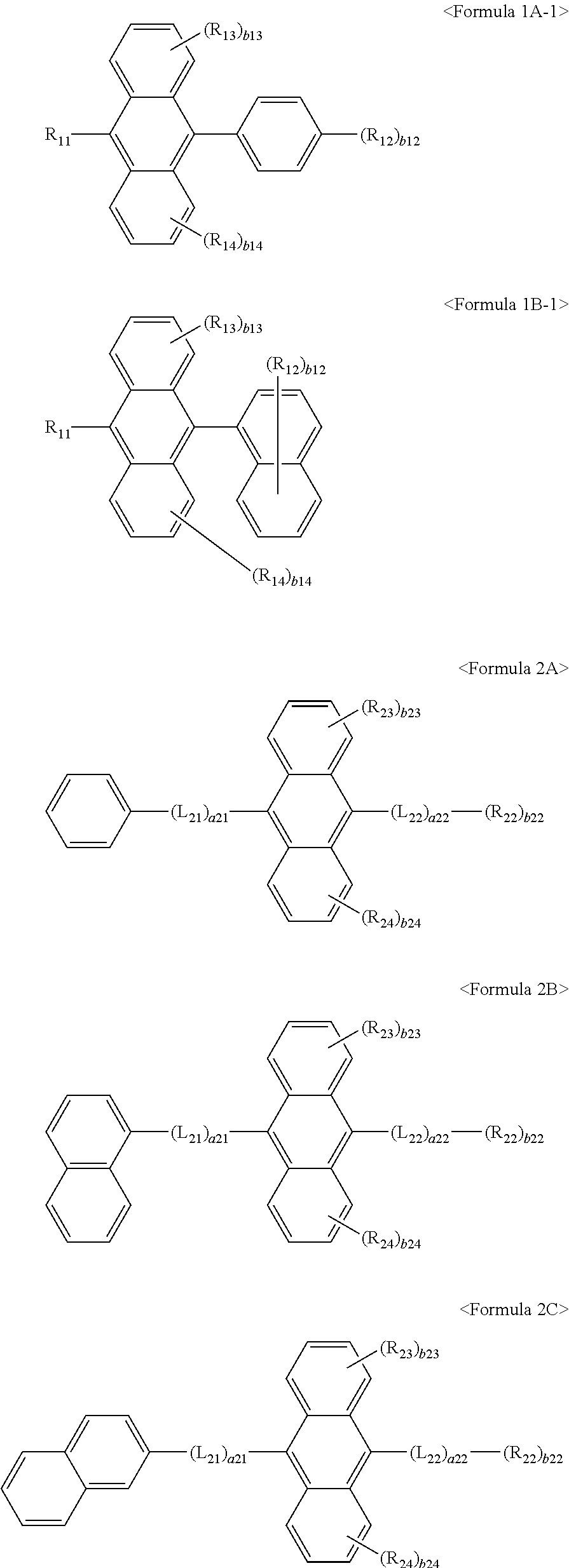
C00015

C00016

C00017
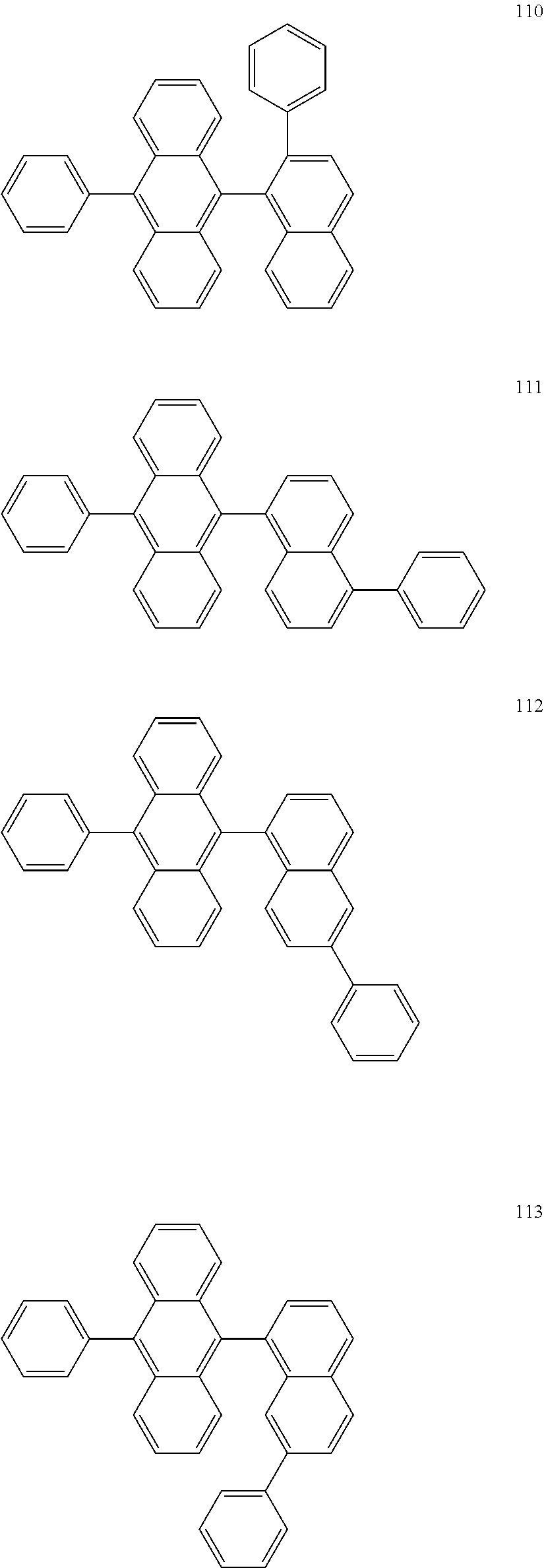
C00018

C00019

C00020

C00021

C00022

C00023

C00024

C00025

C00026

C00027

C00028

C00029

C00030
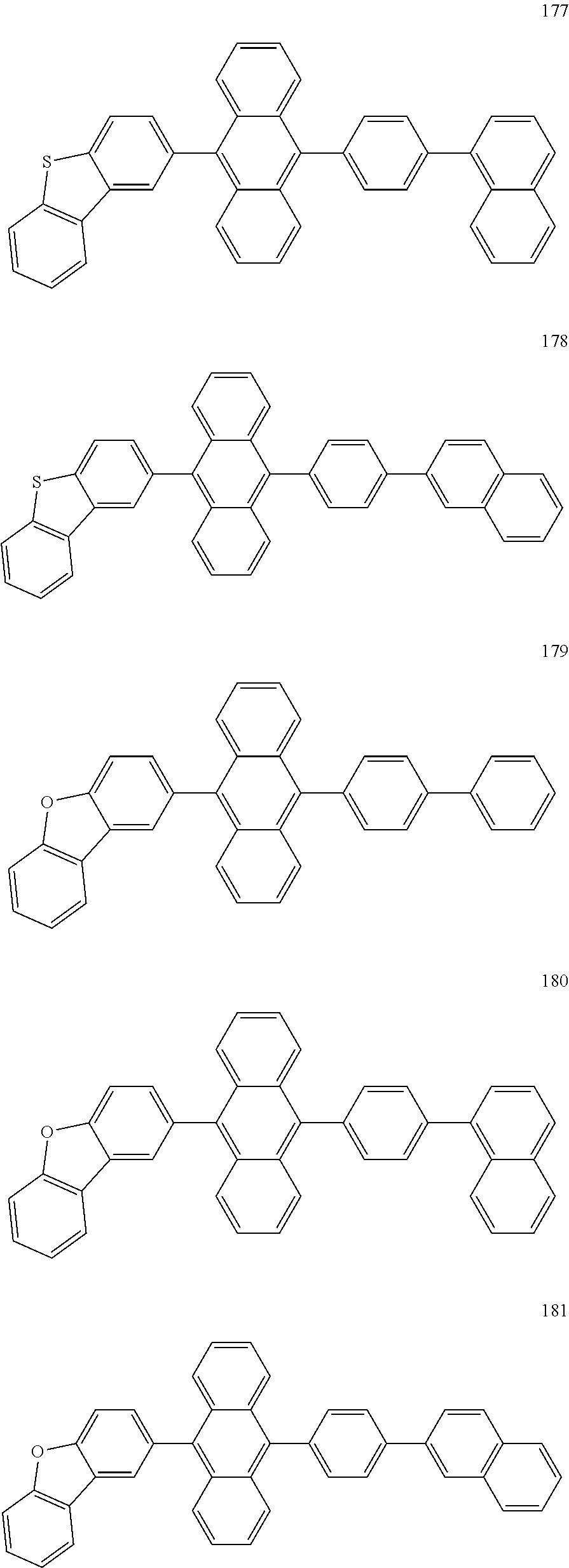
C00031

C00032

C00033

C00034

C00035

C00036

C00037

C00038

C00039

C00040

C00041

C00042

C00043

C00044

C00045

C00046

C00047

C00048

C00049

C00050

C00051

C00052

C00053

C00054

C00055

C00056

C00057

C00058

C00059
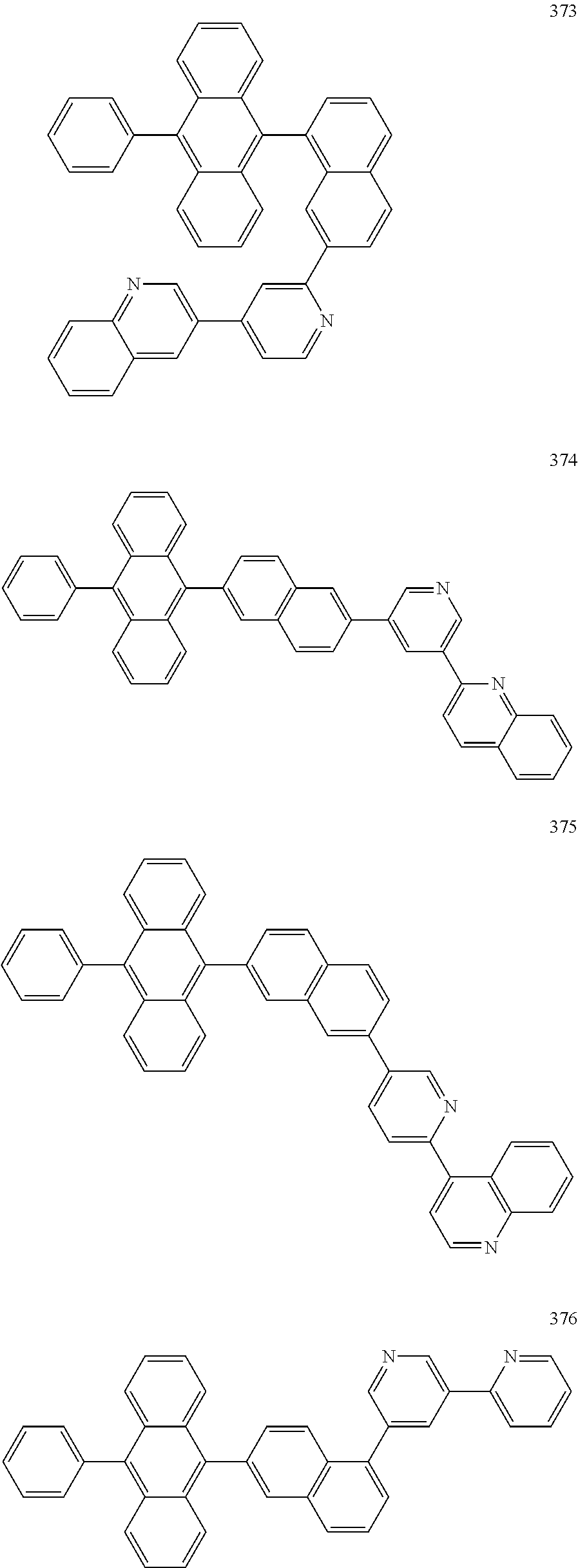
C00060

C00061

C00062

C00063

C00064

C00065

C00066
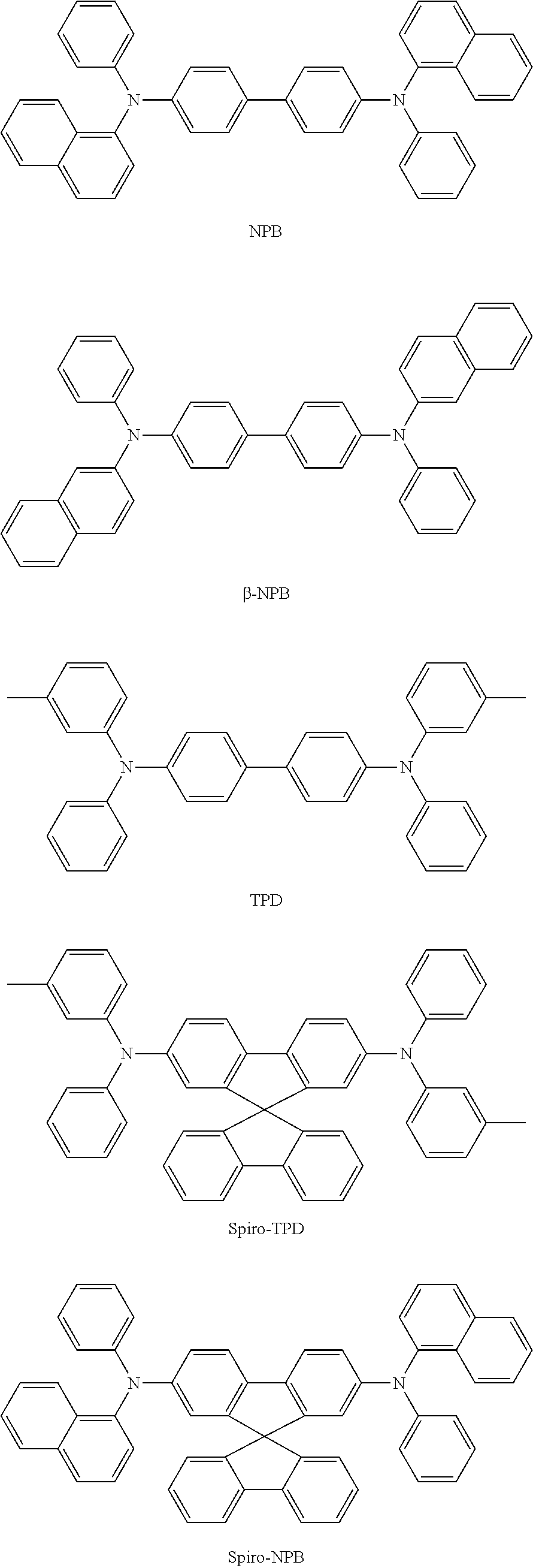
C00067

C00068

C00069
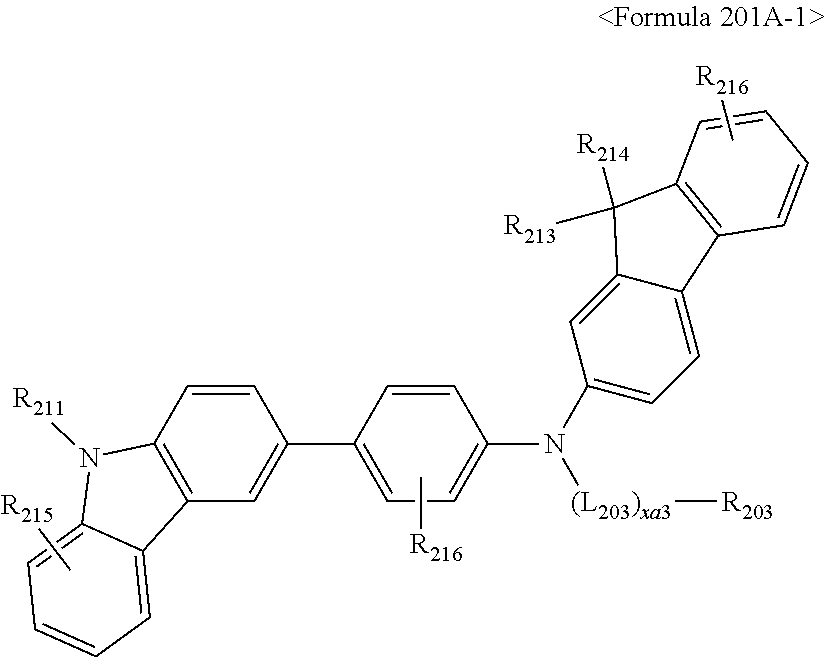
C00070

C00071

C00072
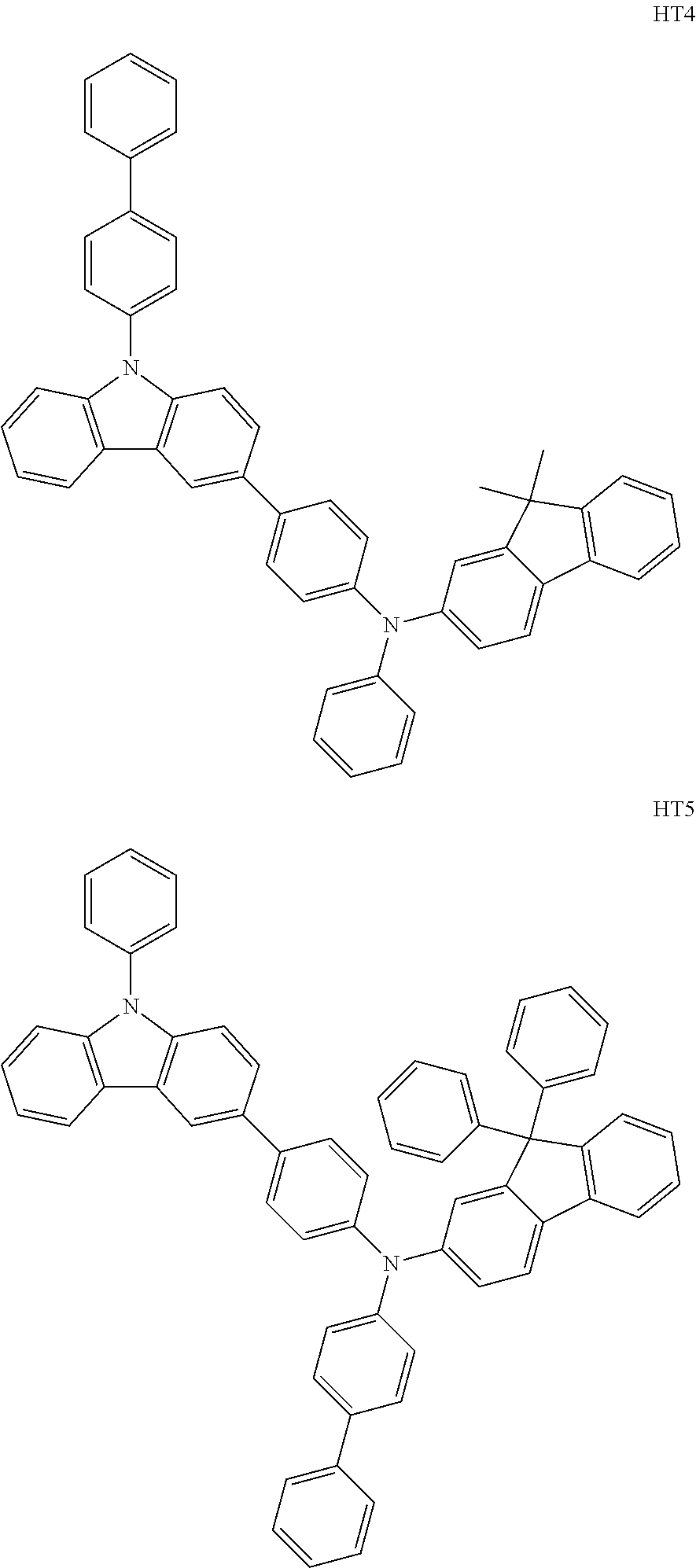
C00073
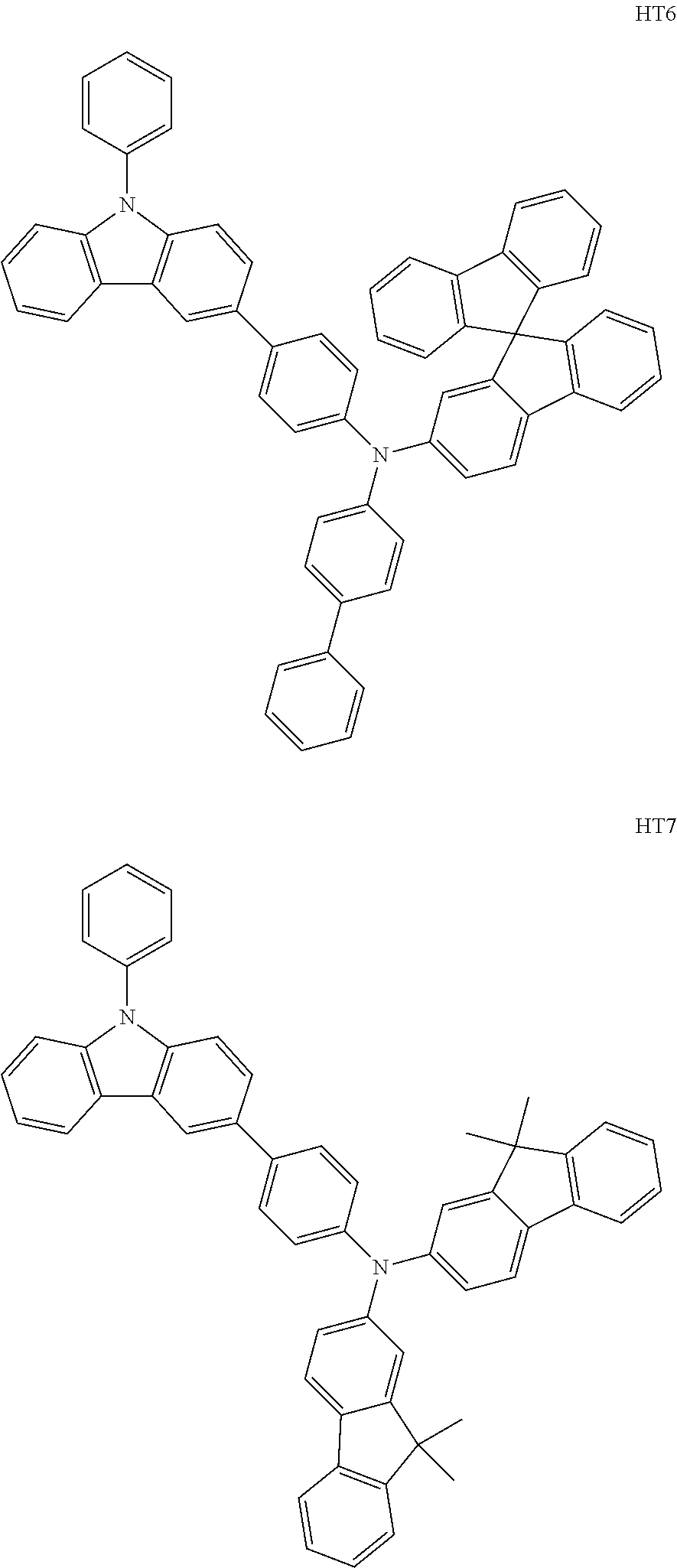
C00074

C00075
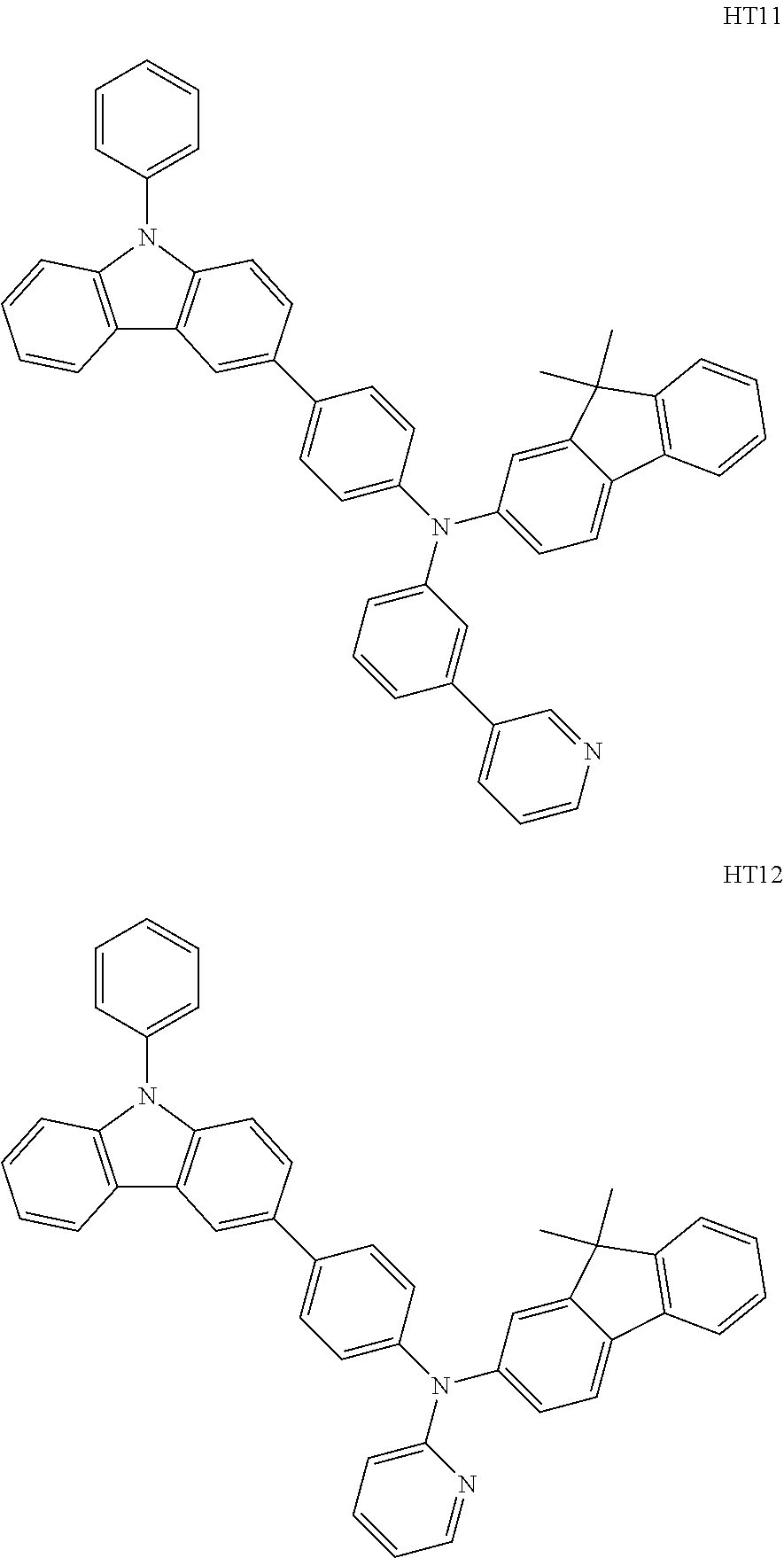
C00076

C00077

C00078

C00079

C00080

C00081

C00082
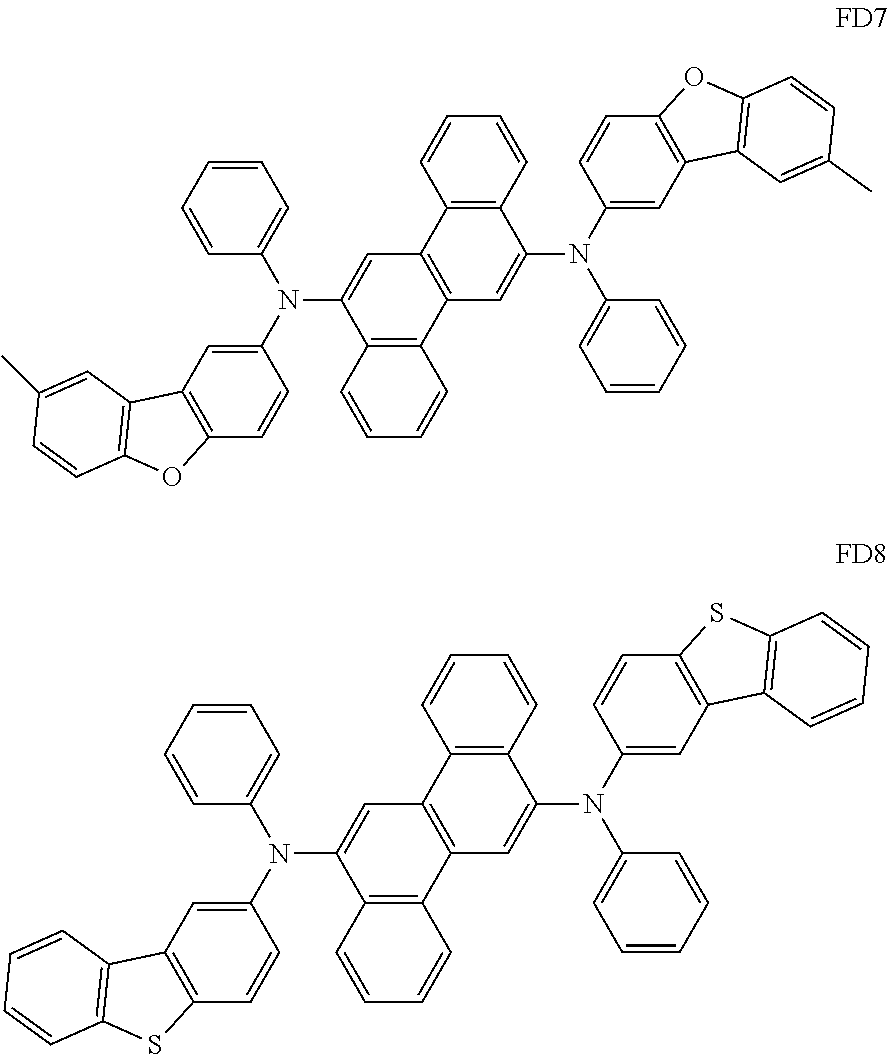
C00083
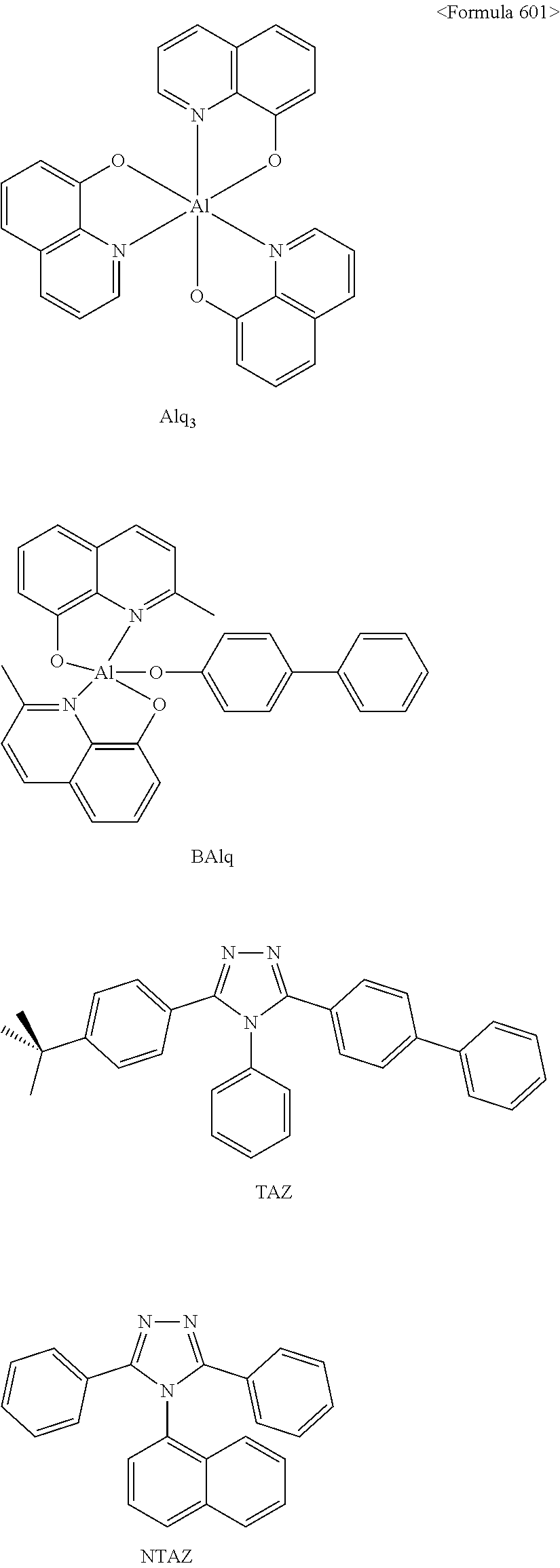
C00084

C00085

C00086
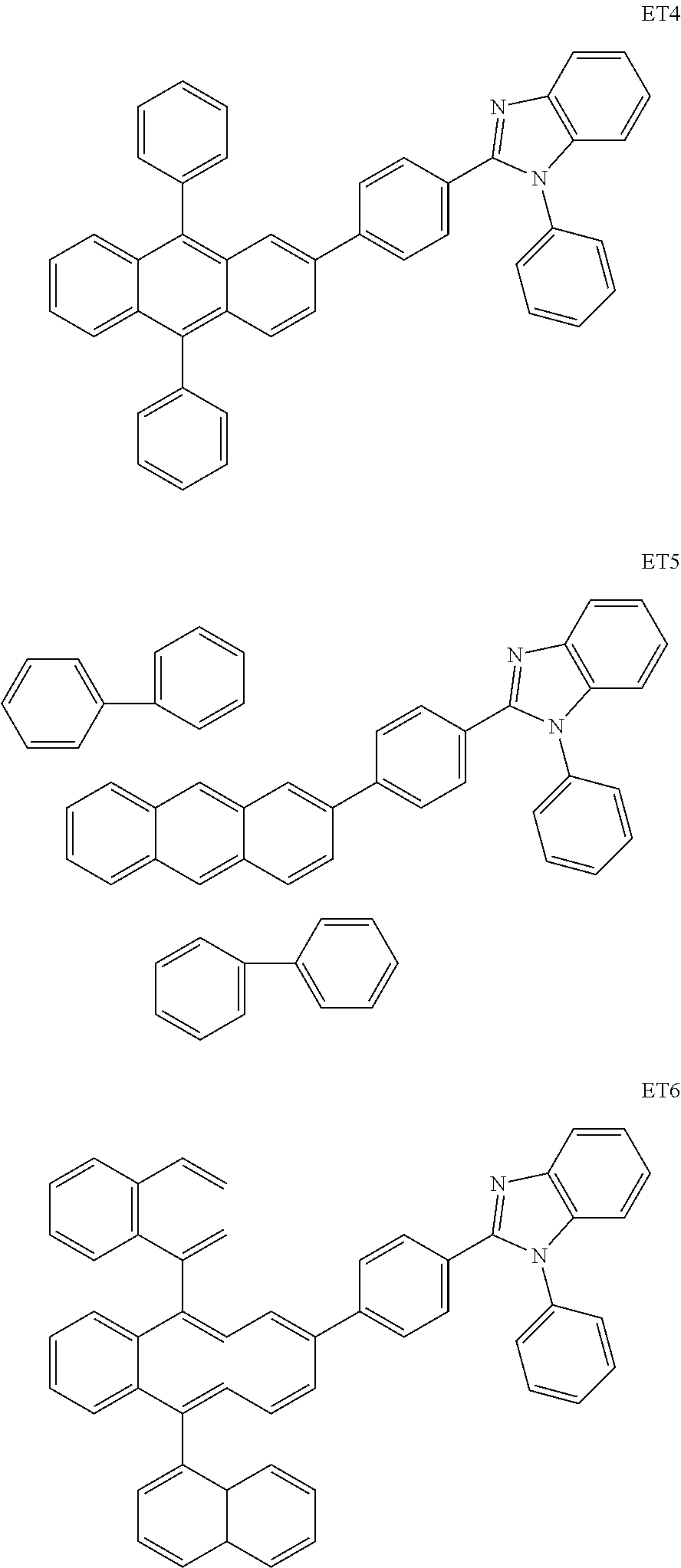
C00087

C00088

C00089
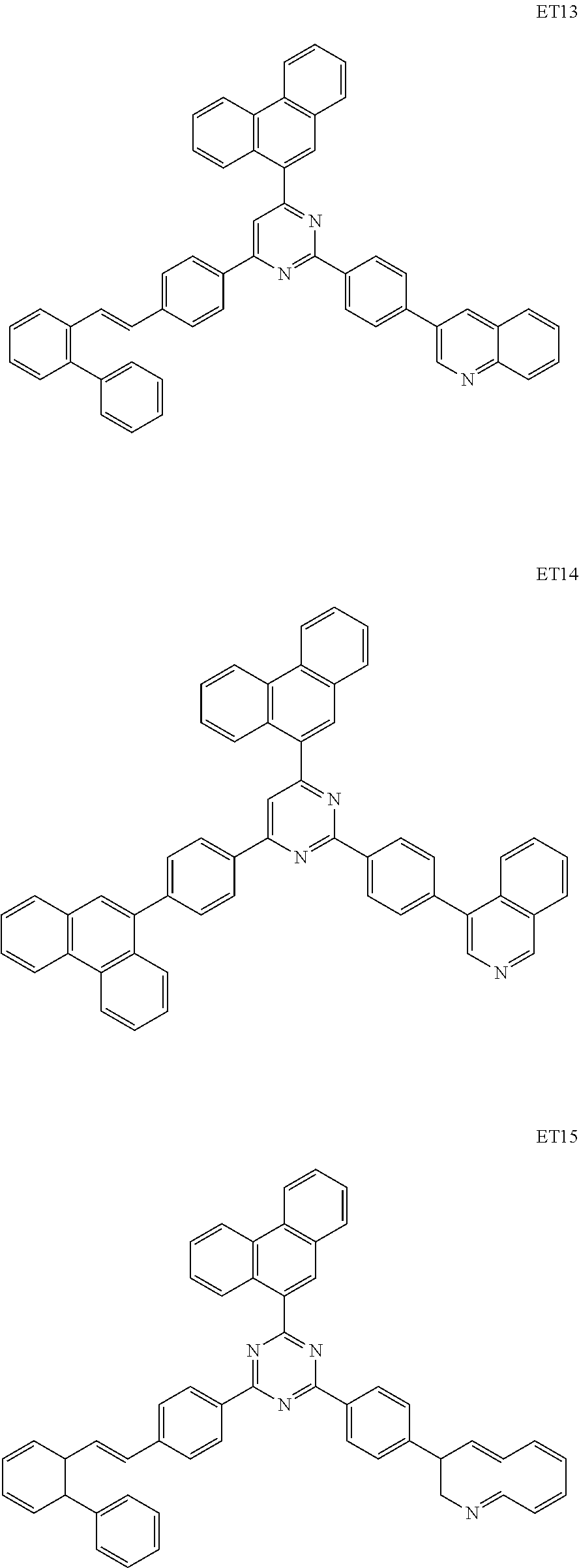
C00090

C00091

C00092

C00093

C00094

C00095

C00096
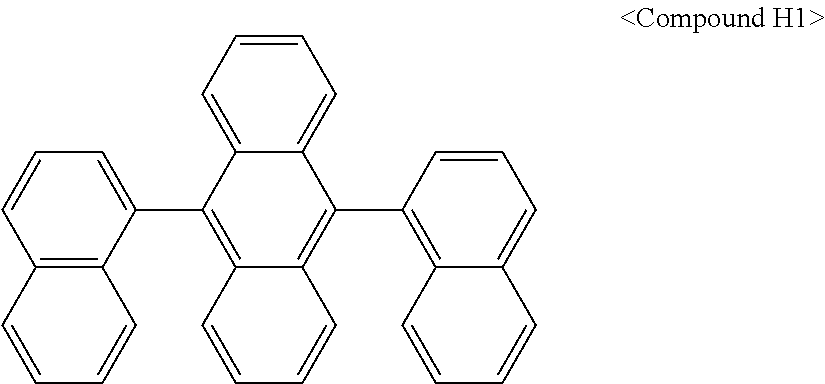
C00097

C00098
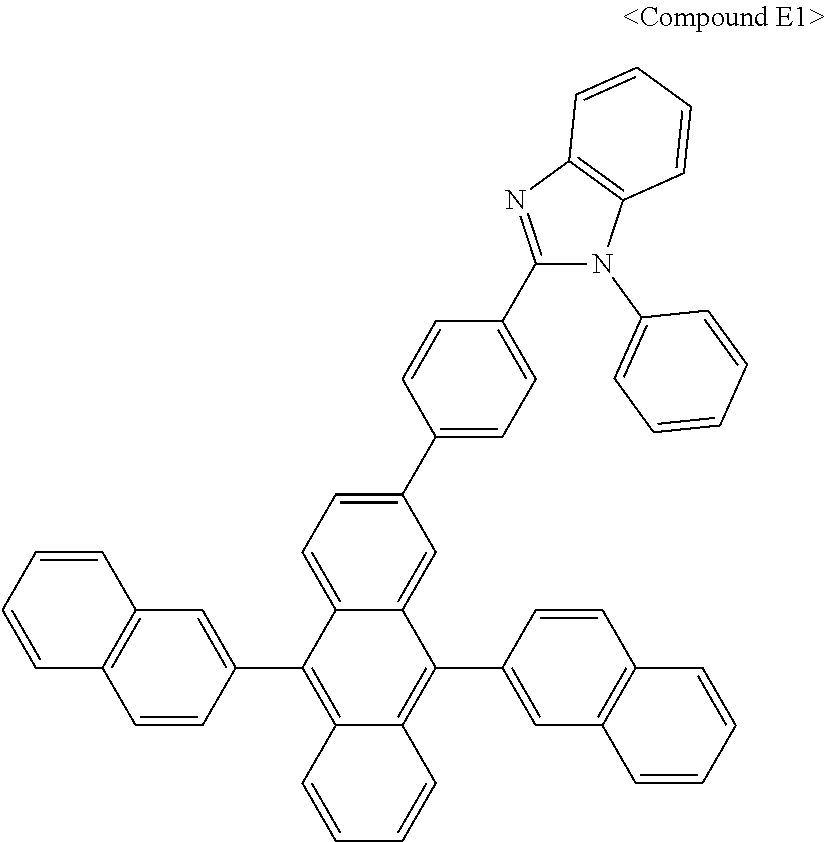
C00099

C00100

C00101

C00102
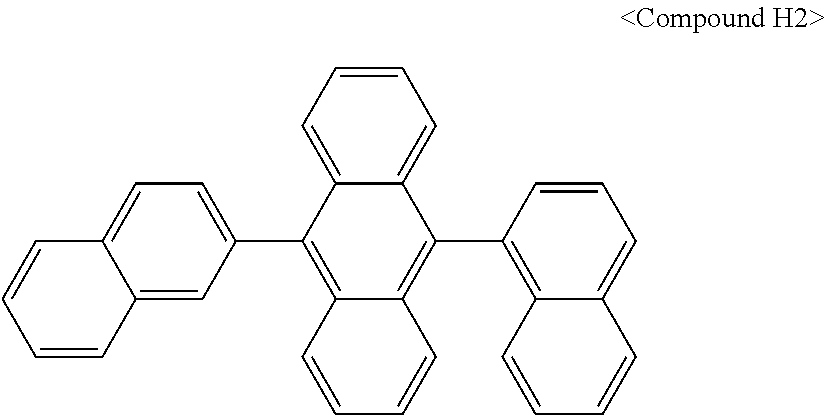
C00103
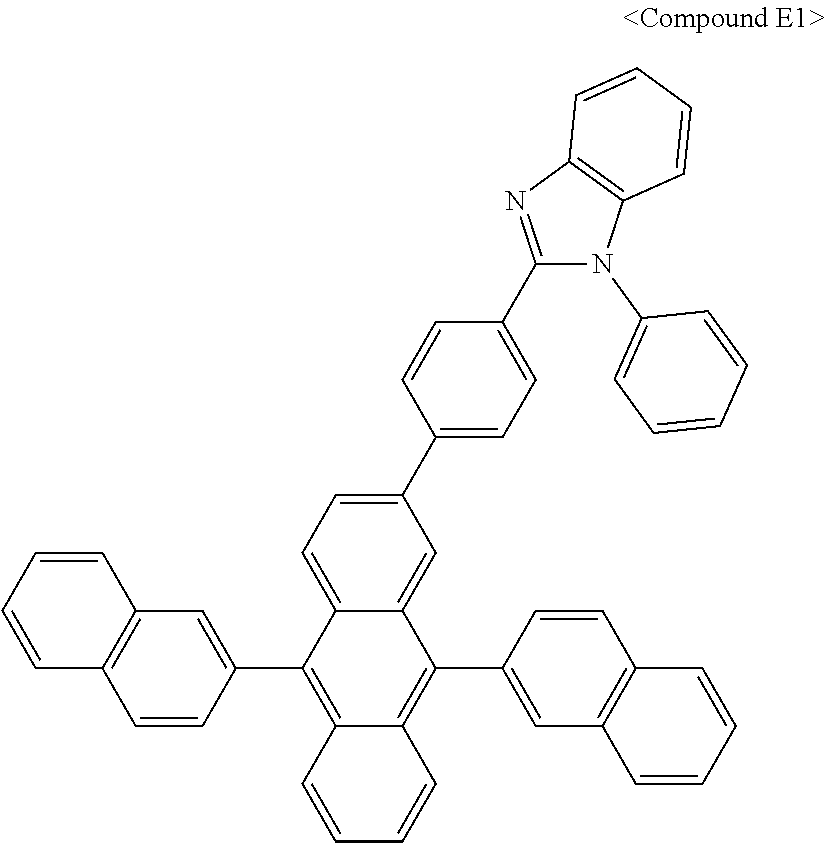
C00104

C00105
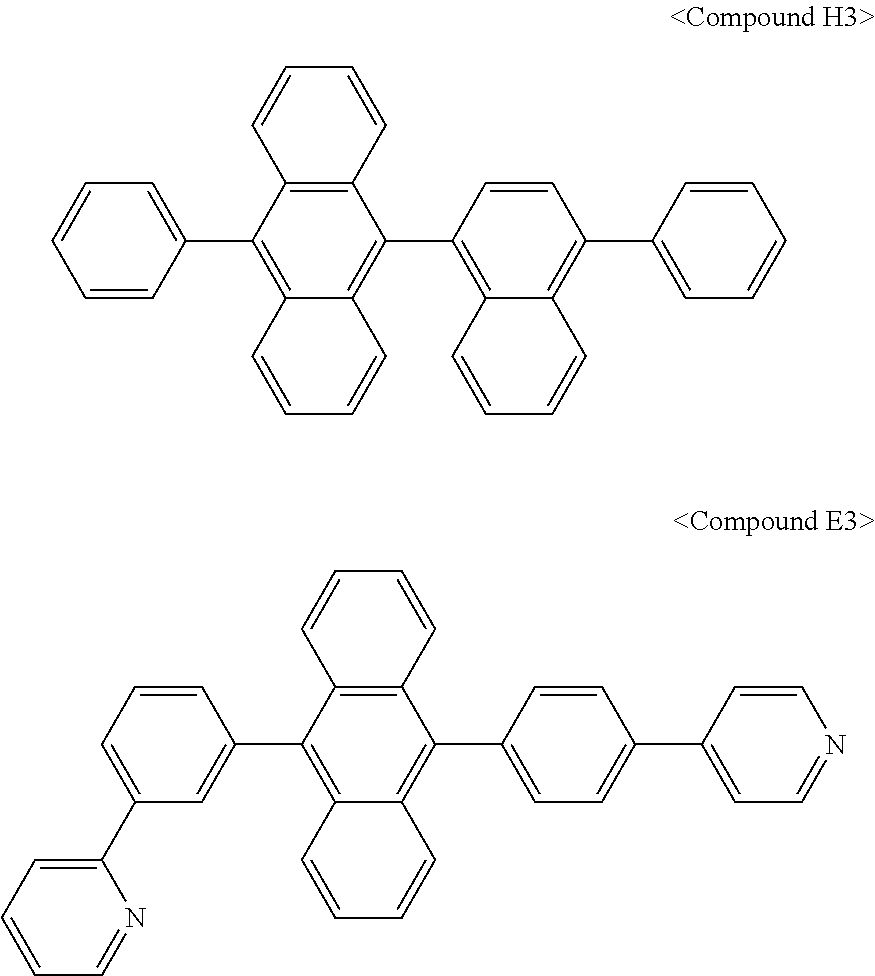
C00106

C00107

C00108

C00109

C00110

C00111

C00112

D00001
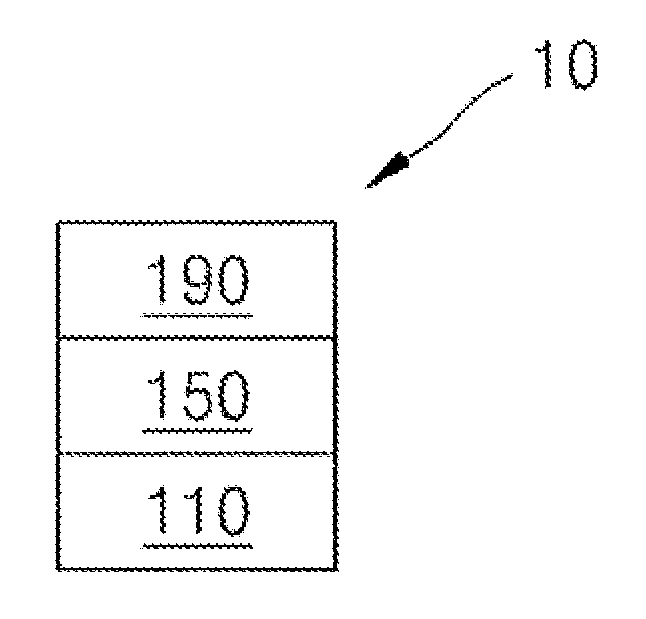
XML
uspto.report is an independent third-party trademark research tool that is not affiliated, endorsed, or sponsored by the United States Patent and Trademark Office (USPTO) or any other governmental organization. The information provided by uspto.report is based on publicly available data at the time of writing and is intended for informational purposes only.
While we strive to provide accurate and up-to-date information, we do not guarantee the accuracy, completeness, reliability, or suitability of the information displayed on this site. The use of this site is at your own risk. Any reliance you place on such information is therefore strictly at your own risk.
All official trademark data, including owner information, should be verified by visiting the official USPTO website at www.uspto.gov. This site is not intended to replace professional legal advice and should not be used as a substitute for consulting with a legal professional who is knowledgeable about trademark law.